Choosing outdoor plants for a patio is an invitation to weave fragrance, texture, and color into the place you sip coffee or gather friends. The 25 entries below span sun-worshipping bloomers, shade-loving foliage stars, and even petite trees, so you’ll find something for every exposure and style. Wherever you live, remember the container basics experts stress — loose, well-draining potting mix, a pot at least as wide as the eventual root ball, and consistent moisture checks during heat waves. With those essentials settled, let’s explore patio possibilities.
1. Fragrant Lavender Brings Drought-Proof Elegance to the Patio
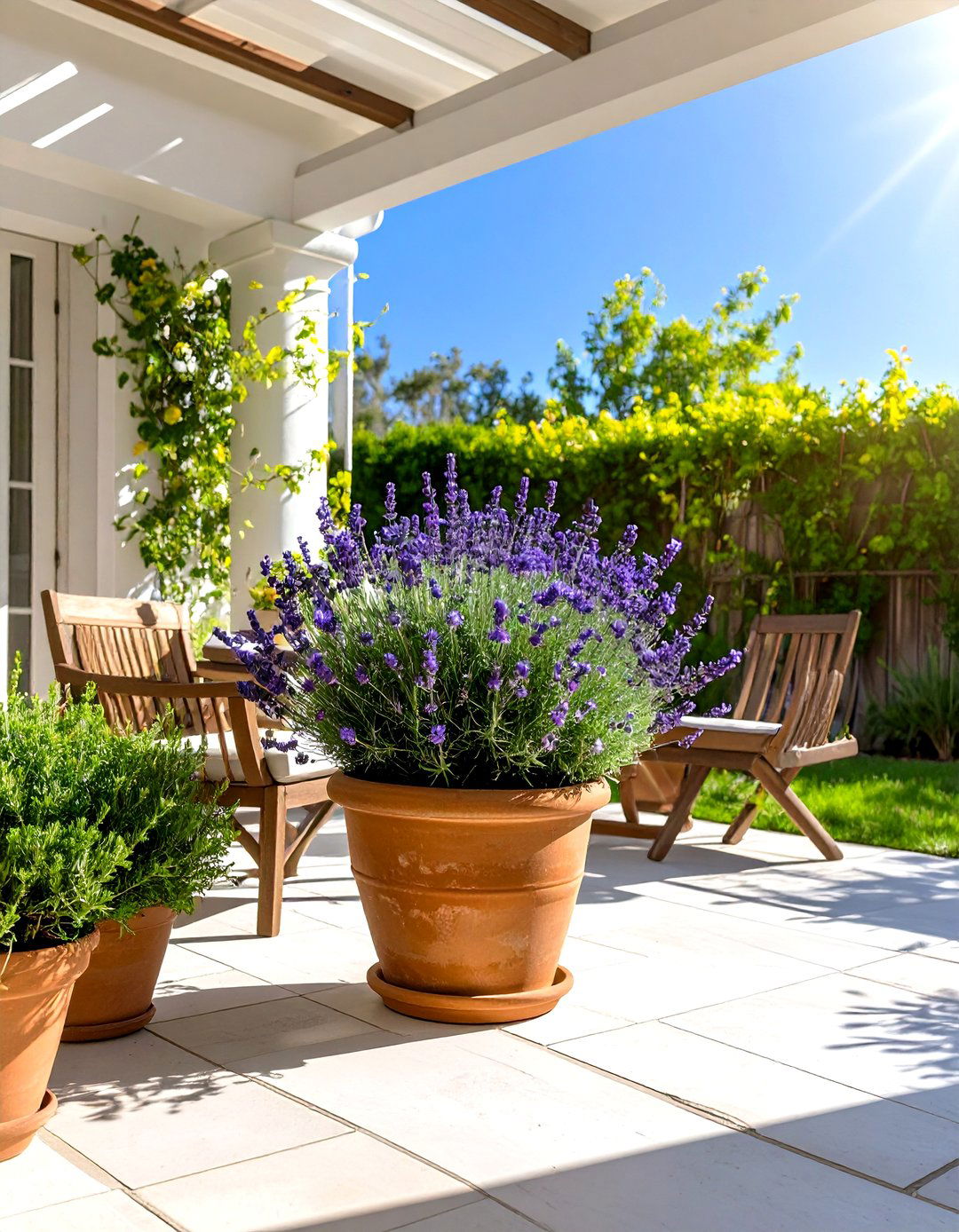
A sun-soaked patio feels instantly Mediterranean when a pot of lavender sits nearby, releasing its soothing, herbaceous perfume. Lavandula angustifolia prefers a lean, sharply drained mix and rewards gardeners who water only after the top inch of soil dries. Set the container where it will bask in at least six hours of direct sun to keep oils high and stems compact. Light shearing after the first bloom flush encourages fresh growth and another round of purple wands. Beyond its beauty, this outdoor plant for patio spaces repels mosquitoes while attracting bees, offering comfort and conservation in the same clay pot.
2. Hardy Rosemary Doubles as Patio Topiary and Kitchen Staple
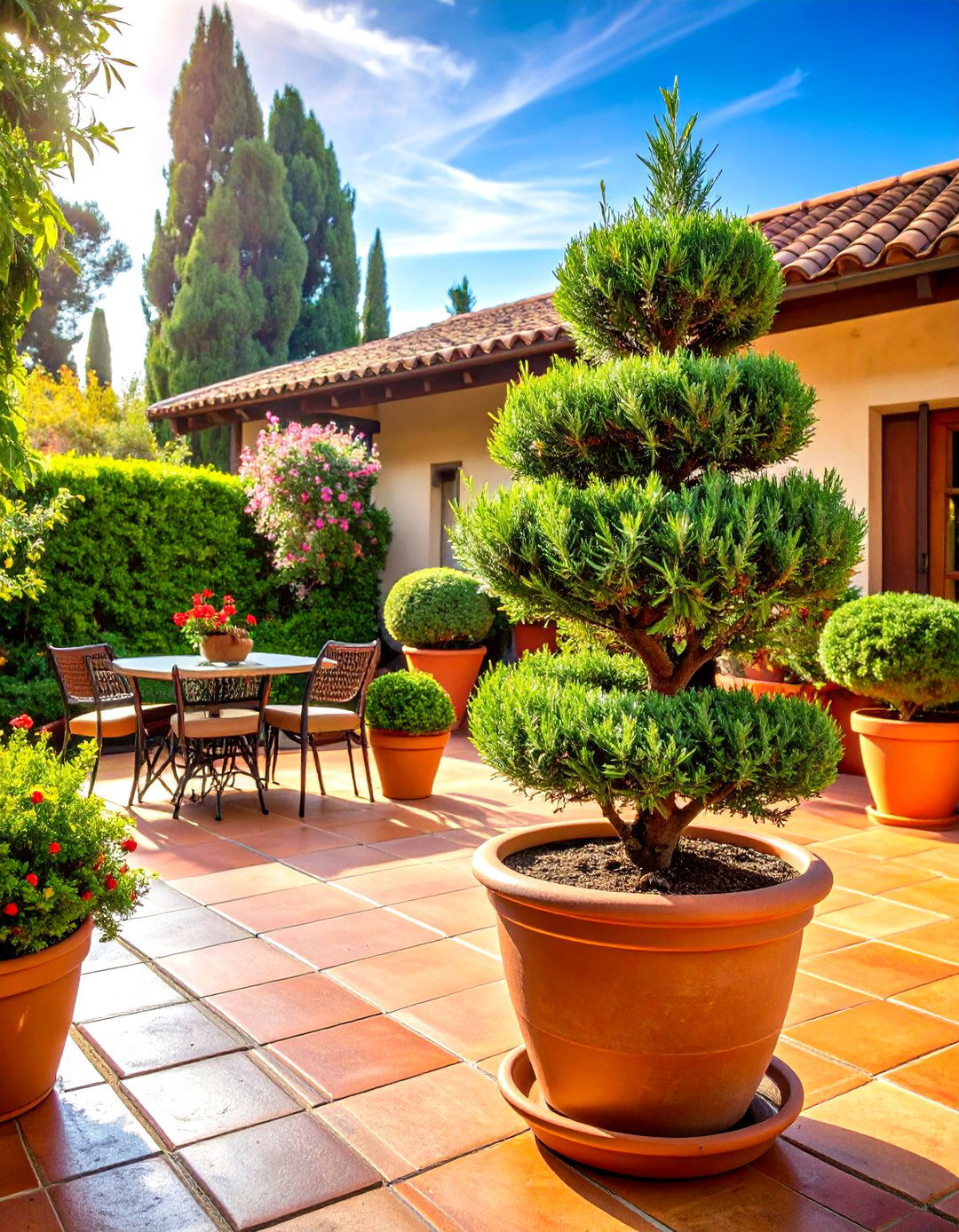
The evergreen needles and pine-clean scent of rosemary make a patio feel like the hills of Tuscany. Rosmarinus officinalis shrugs off wind, salt spray, and drought once established, thriving in the high-heat microclimate patios often create. Give the herb six to eight hours of sunshine and a porous soil blend; soggy roots are its only real foe. Clip stems freely for cooking — regular harvesting actually keeps the plant dense and encourages new shoots. A small spiral or standard topiary form turns this practical herb into living sculpture beside your bistro set.
3. Sun-Loving Geraniums Supply Season-Long Color in Compact Pots
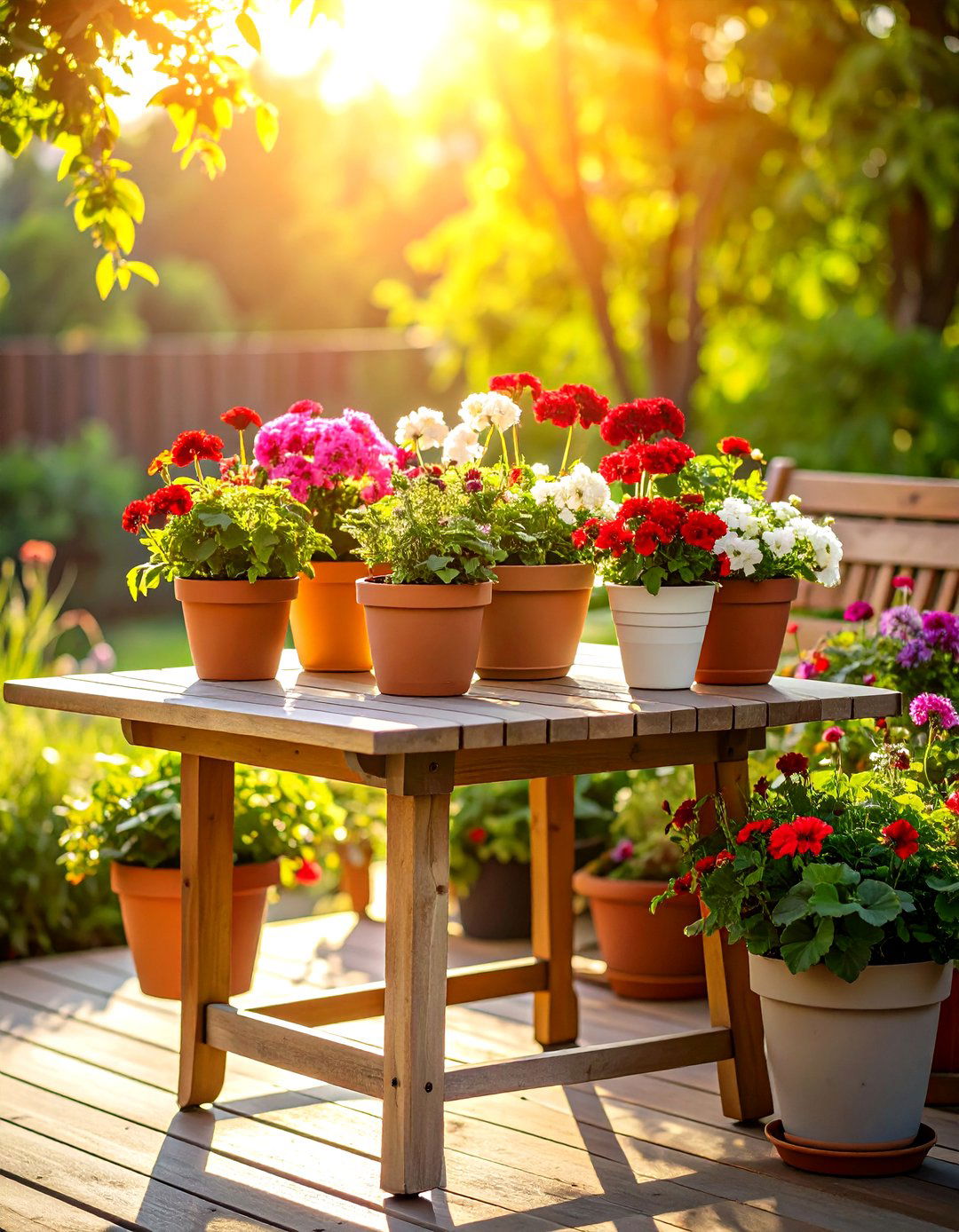
What patio feels complete without the citrus scent and constant color of zonal geraniums? Pelargoniums flower best with four to eight hours of direct light, though a touch of afternoon shade prevents bloom fade in scorching climates. Use a moisture-retentive yet airy potting mix, watering when the top inch dries to dodge root rot. Deadhead spent umbels weekly for nonstop blooms and more lateral branching. Their tidy habit means even a 10-inch pot can host a bold show, making these outdoor plants for patio railing boxes or tabletops equally successful.
4. Petunias Paint the Patio With Cascading Trumpets
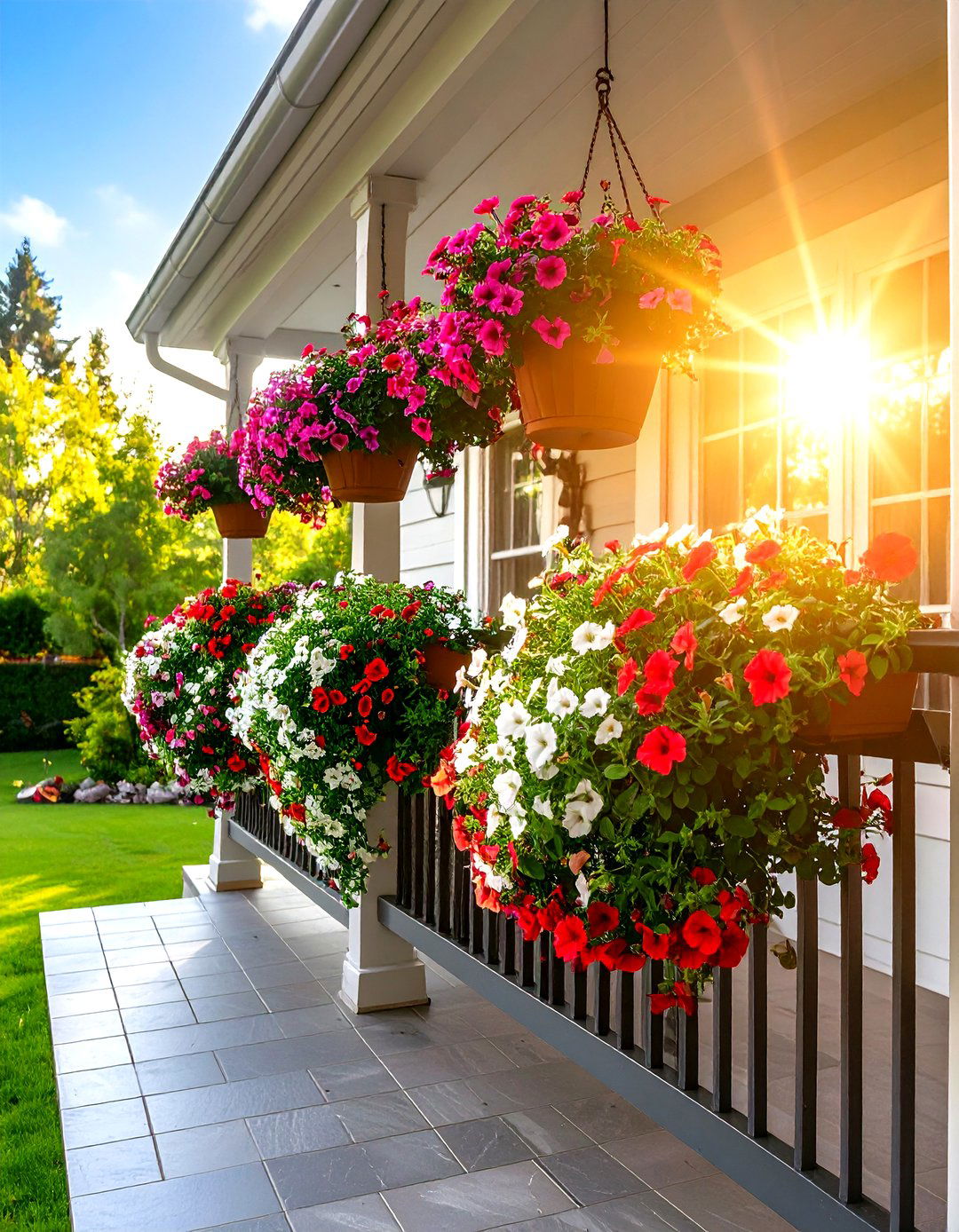
Few outdoor plants for patio baskets outperform modern petunias for nonstop, jewel-tone carpets. They insist on at least six hours of full sun for the thickest bloom set. Because petunias are heavy feeders, mix slow-release fertilizer into soil, then supplement every two weeks with a liquid feed to keep trumpets rolling. Water deeply whenever the top 2 cm feel dry; shallow sips lead to lank growth. Pinch back stems by one-third mid-summer to reinvigorate flowering and maintain a billowing shape over patio railings.
5. Tropical Mandevilla Climbs Up Trellises for Resort-Style Flair
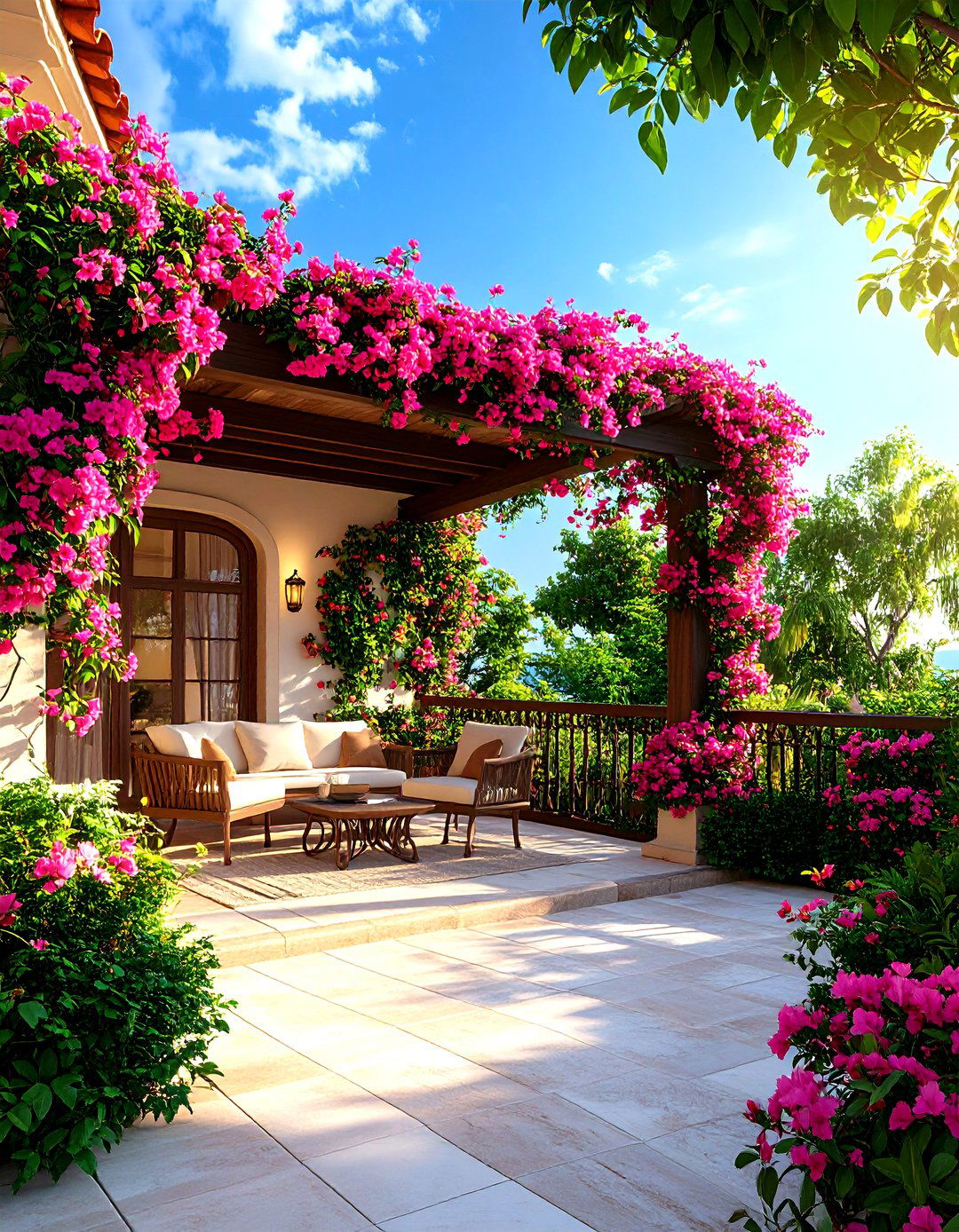
Unlike many vines, mandevilla thrives in containers, provided it receives four to six hours of direct sun and evenly moist, humus-rich soil. Train shoots up a trellis or obelisk to save floor space and create a vertical “living wall” of lipstick-pink trumpets. Feed every two weeks with half-strength balanced fertilizer to prolong bloom season. Before nights dip below 10 °C, wheel the pot indoors and overwinter in bright light — a small commitment for a plant that turns any patio into a tropical retreat. Watch for spider mites in dry spells and spritz foliage to keep pests at bay.
6. Dwarf Japanese Maple Lends Sculptural Shade in One Pot
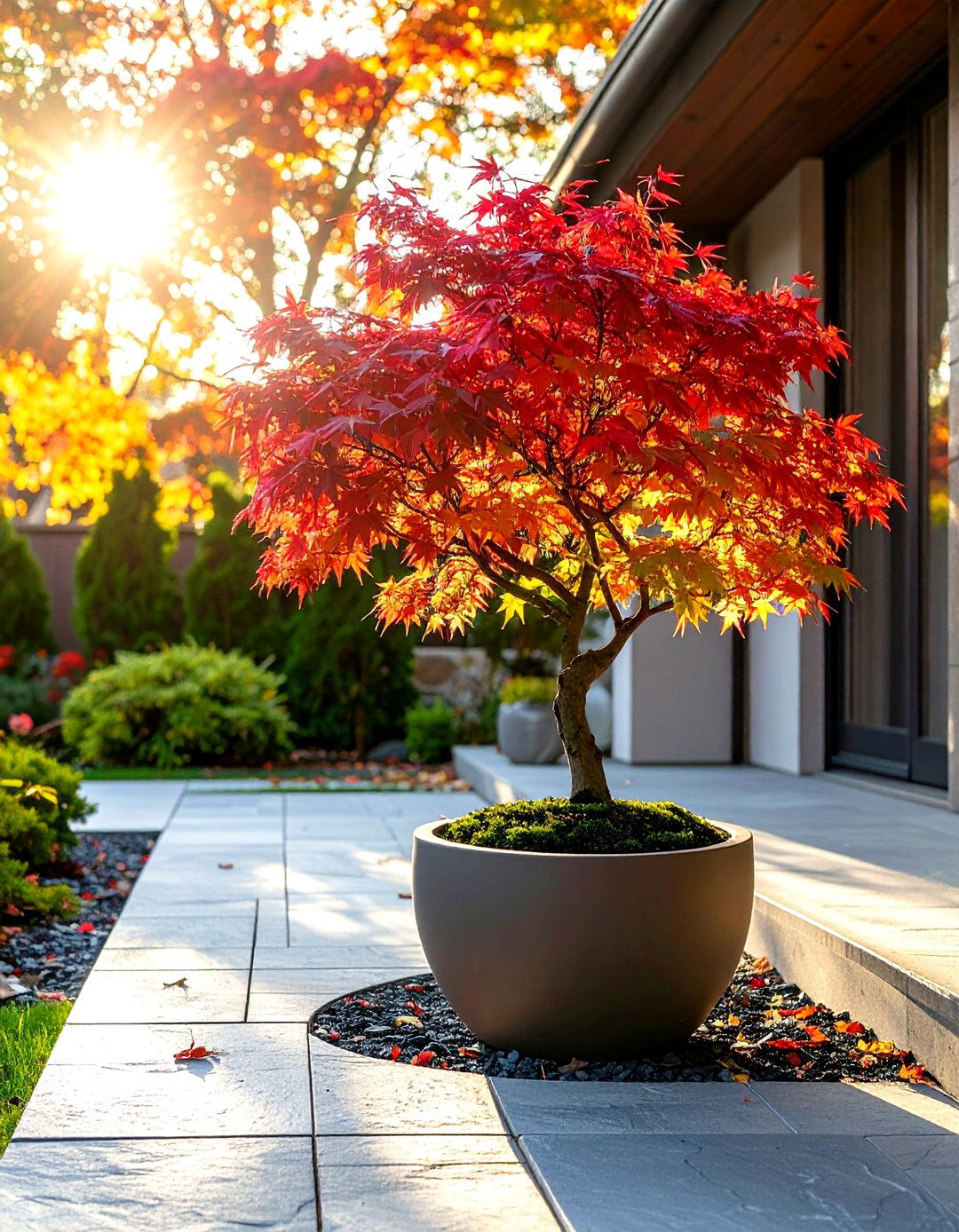
Acer palmatum varieties selected for containers have polite, non-invasive roots and stay under 1. 8 m, making them ideal outdoor plants for patio corners. Position the pot where the tree receives morning sun and afternoon dappled shade to preserve leaf color and prevent scorch. Use a slightly acidic, wood-based mix and water whenever the top few centimeters dry — maples dislike drought in pots. An occasional trim of crossing twigs maintains its airy silhouette. Come autumn, fiery crimson or amber leaves create a seasonal fireworks show only meters from your door.
7. Boxwood Spheres Offer Year-Round Structure and Privacy
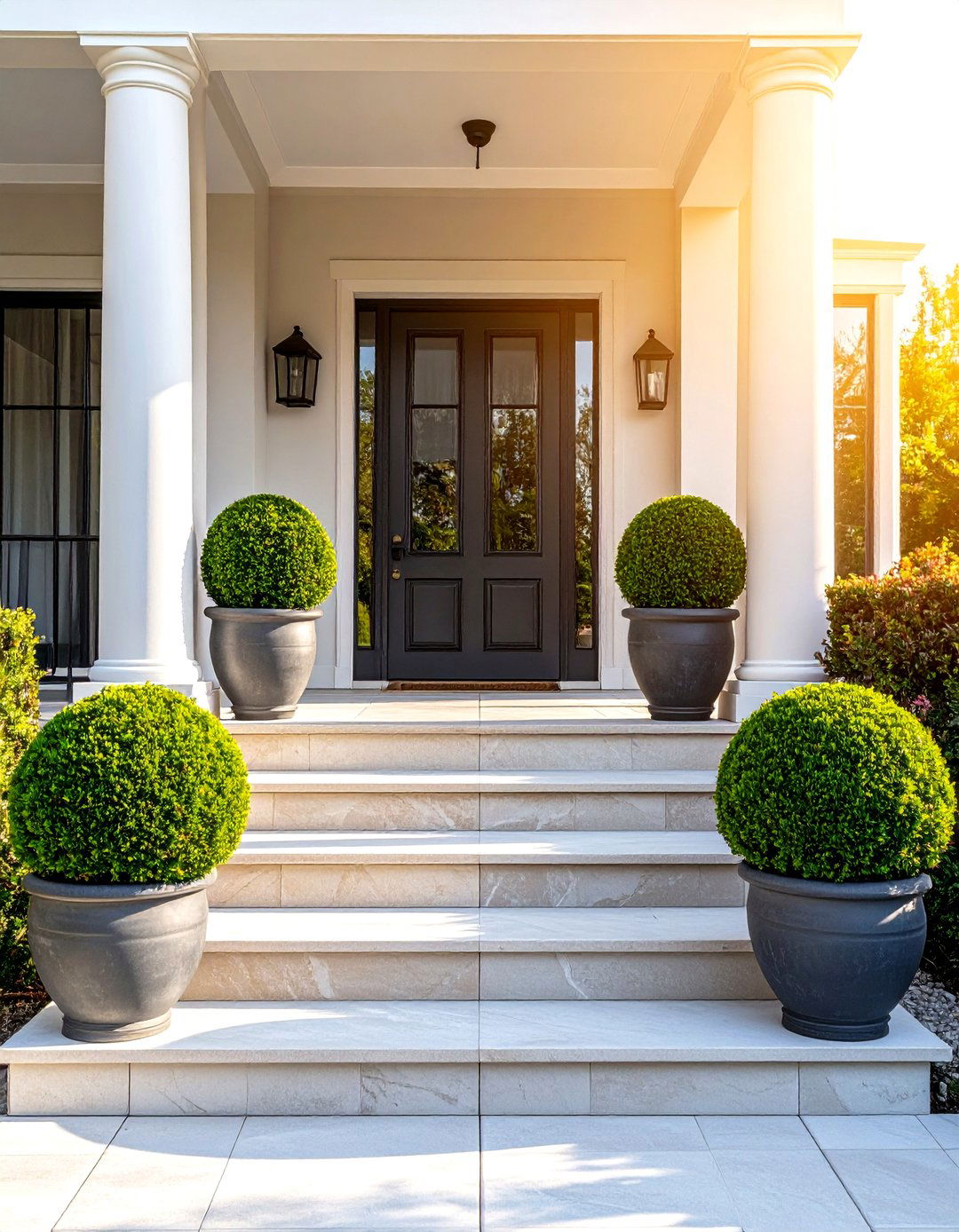
Evergreen boxwoods instantly add formality, whether clipped into spheres or left as soft mounds beside patio seating. Select a container at least as wide as the plant is tall to accommodate its shallow, spreading roots. Provide morning sun and afternoon shade in hot zones to prevent leaf bronzing. Water consistently; dry stresses invite spider mites. A light shearing after each flush keeps shapes crisp, while slow-release fertilizer in spring sustains glossy foliage. Use two matching pots flanking steps to create an inviting, symmetrical entrance to your outdoor room.
8. Boston Fern Delivers Lush, Cooling Green to Shaded Patios
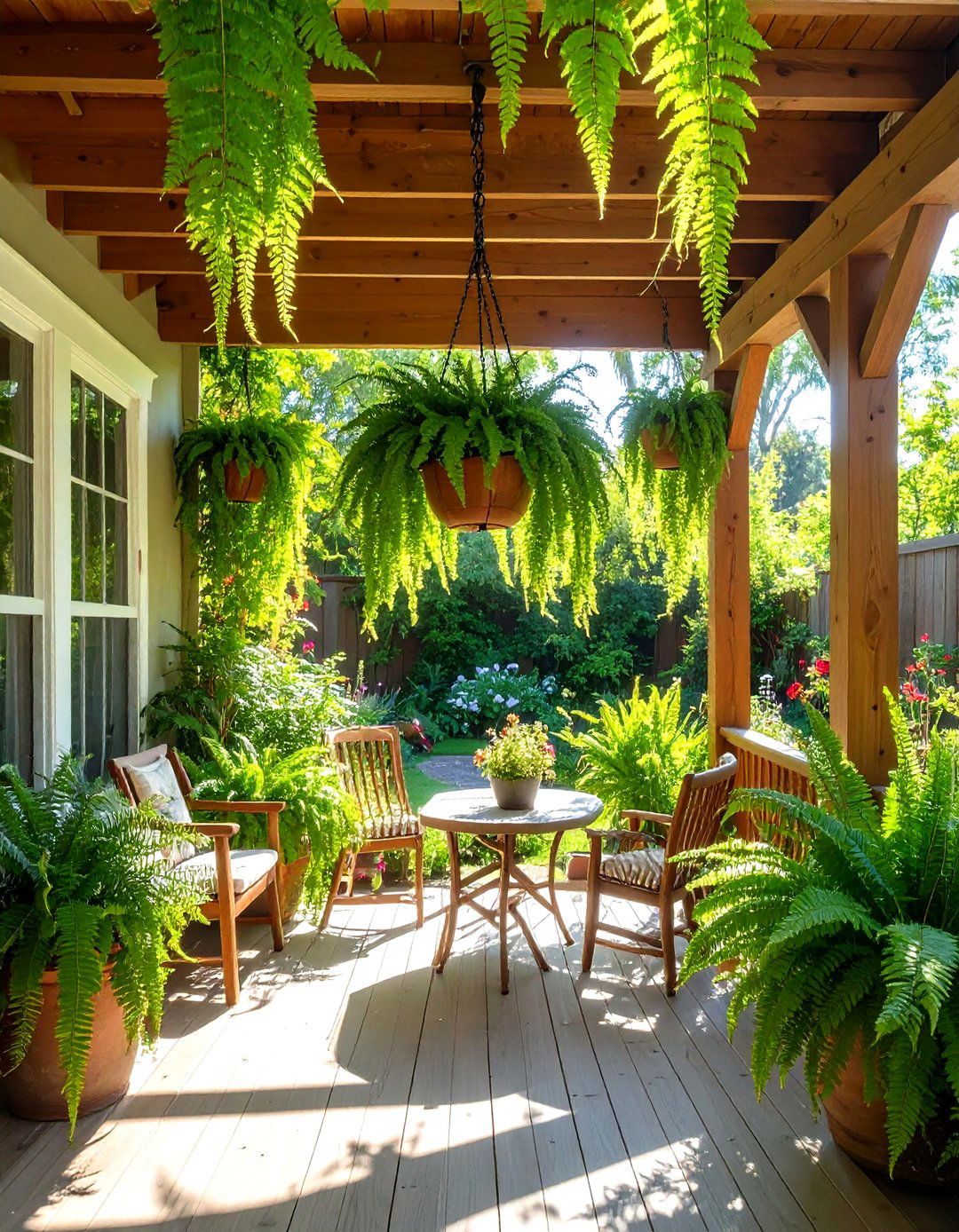
Cascading fronds soften hardscapes and lower the perceived temperature of shaded patios. Nephrolepis exaltata thrives where it receives bright, indirect light and a few hours of gentle morning sun. Keep soil consistently moist but never water-logged; weekly dunking of the entire basket ensures even hydration. High humidity prevents crispy tips, so mist during heat waves or stand the pot on a pebble tray. Monthly liquid feedings replace nutrients flushed out by frequent watering. This outdoor plant for patio overhangs turns even small balconies into mini jungles.
9. Mophead Hydrangeas Bring Big Drama to Partial-Sun Spots
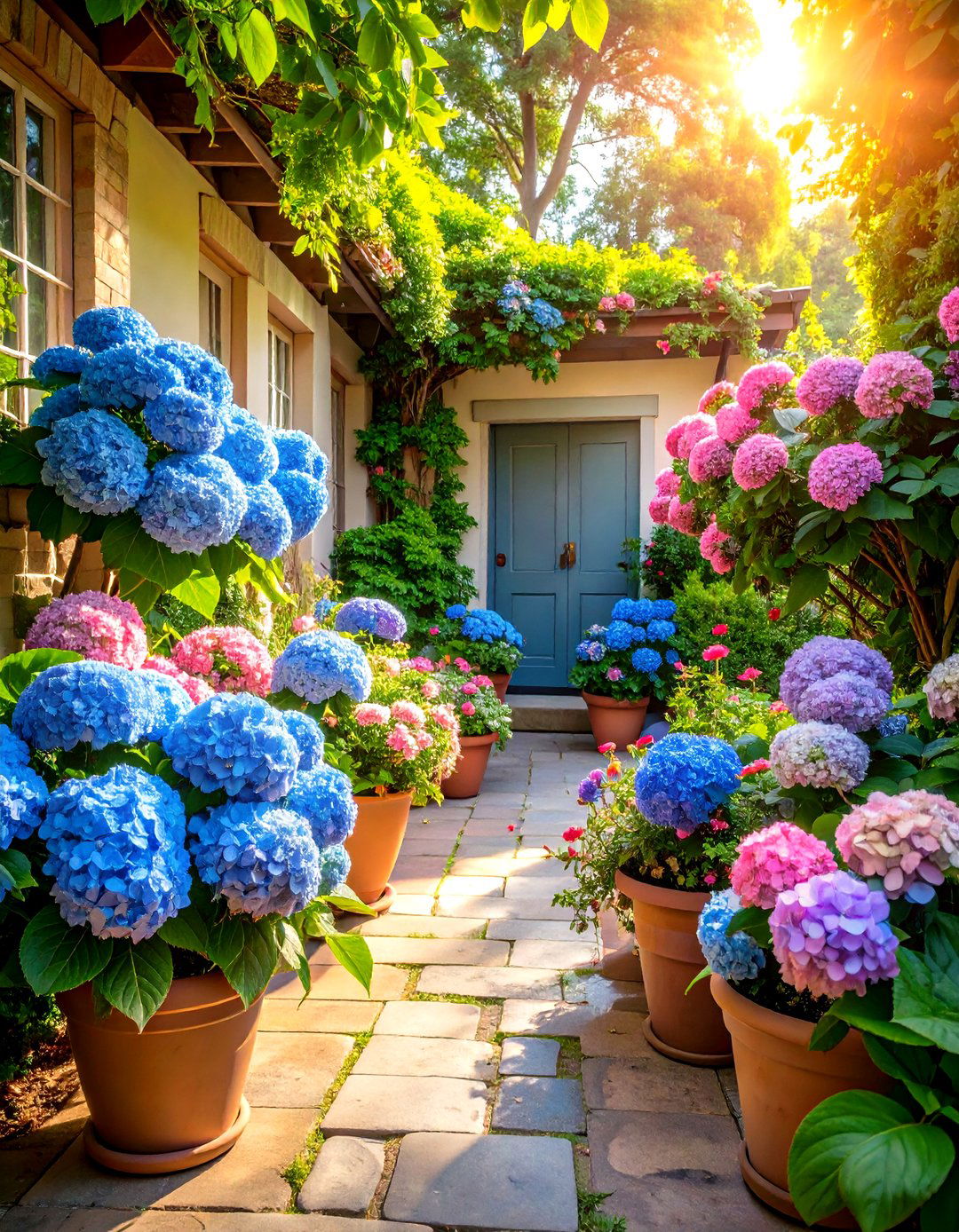
Container hydrangeas let renters enjoy head-sized blooms without digging beds. For best flowering, place the pot where it receives four to six hours of sun, with afternoon shade in hotter regions. Use a moisture-retentive mix and water when the top 2 cm feel dry; drooping leaves signal thirst. Prune lightly after flowering to maintain shape and encourage next year’s buds. Because pots are mobile, you can wheel the shrub into winter shelter in cold zones, extending its life far beyond one season.
10. Caladium Fires Up Shade With Heart-Shaped Neon Leaves
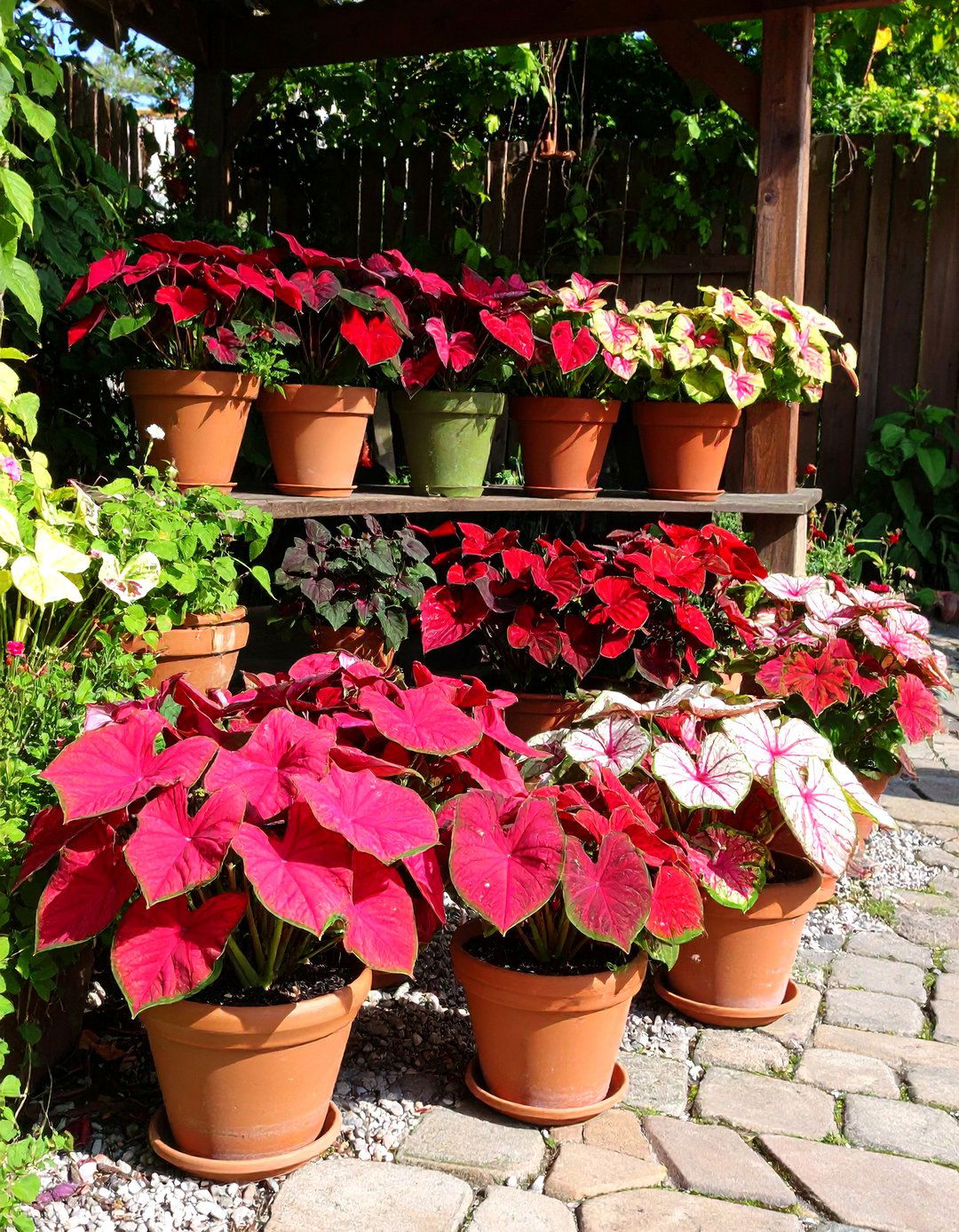
Heart-to-heart caladium cultivars glow in bright shade, lighting dark patio corners where flowers sulk. Most varieties flourish on four to six hours of filtered light, though some tolerate full sun with ample moisture. Plant tubers shallowly in a rich, slightly acidic mix and keep soil evenly damp. Monthly feeding with a balanced fertilizer preserves vivid color. Allow foliage to yellow in autumn, then lift and store the tubers dry indoors if winters drop below 10 °C — next spring they’ll power up again with minimal effort.
11. Color-Splash Coleus Thrives Where Sun and Shade Intersect
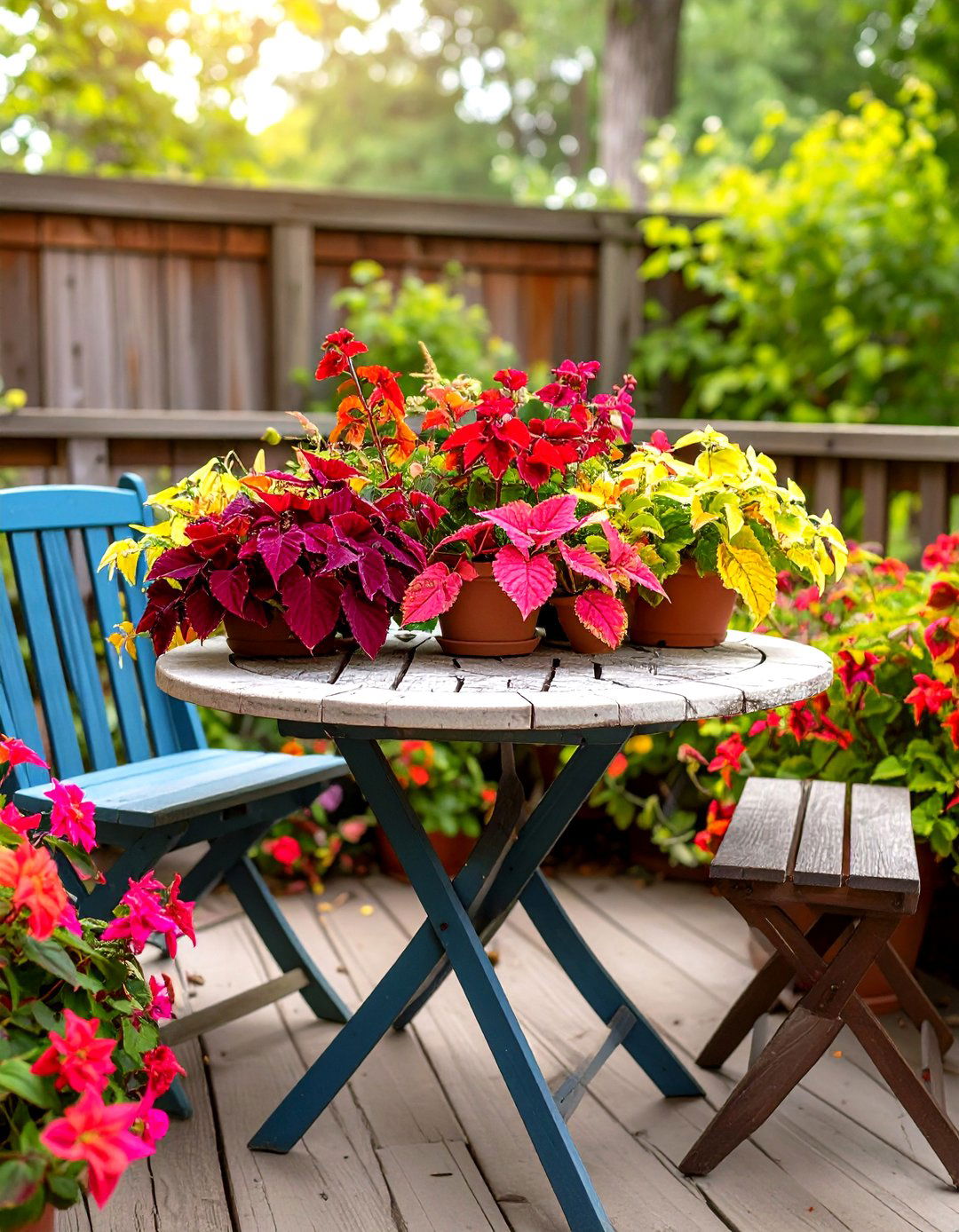
Surprisingly sun-tolerant modern coleus varieties still show their richest tones with morning sun and afternoon shade. Pinch the tips every few weeks to encourage bushy growth and discourage early flowering, which saps foliage vibrancy. Keep the soil lightly moist but never soggy, and feed bi-weekly with a nitrogen-lean formula to heighten leaf hues. Because coleus roots stay compact, even a 20 cm pot can explode with chartreuse, burgundy, and pink mosaics, making it a low-maintenance outdoor plant for patio tabletops.
12. Fuchsia Offers Hummingbird-Friendly Pendants for Cool Patios
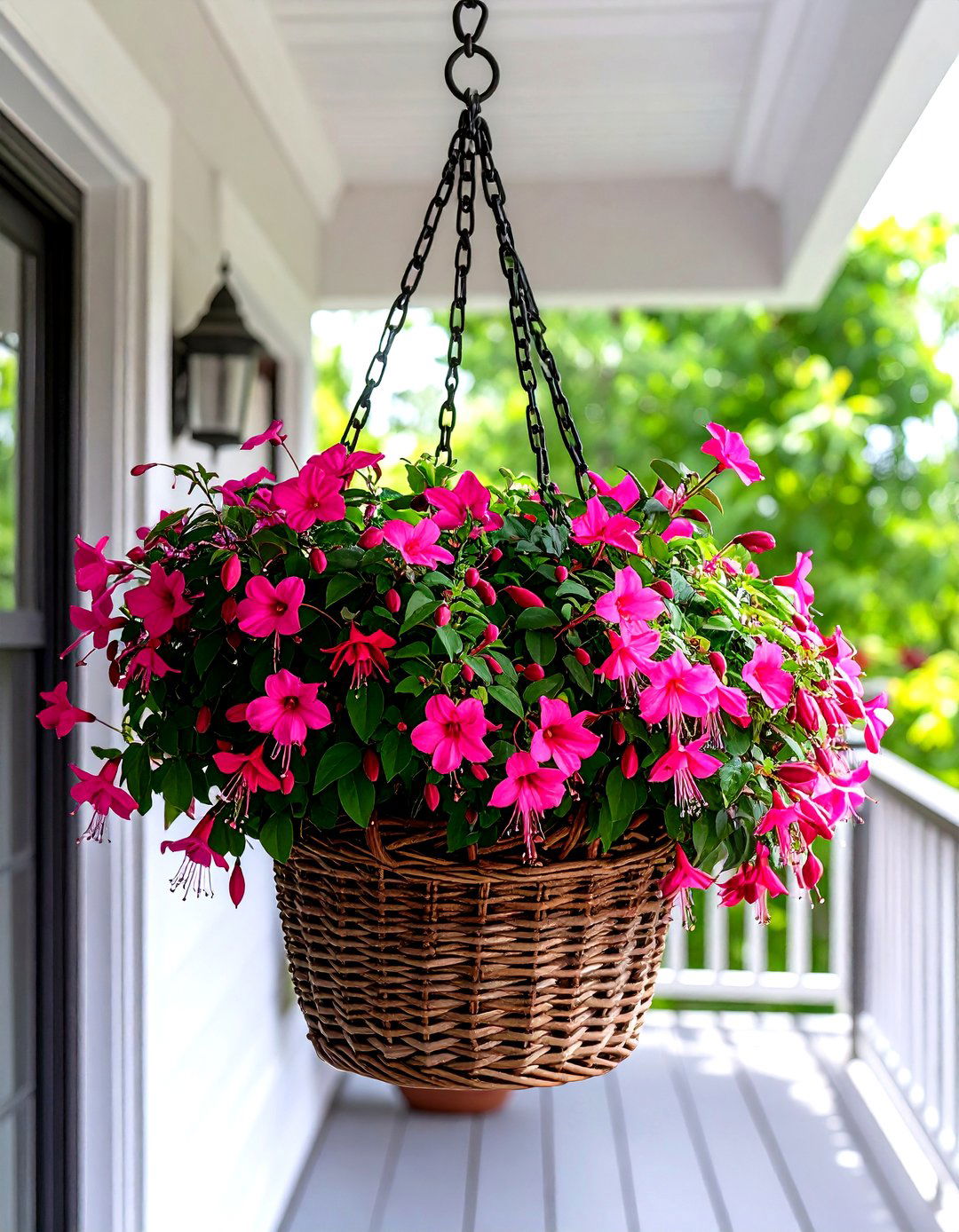
On balconies that enjoy bright mornings and cooler afternoons, fuchsia baskets dangle two-tone blossoms that hummingbirds can’t resist. Most hybrids appreciate bright light with some midday shade, especially in hot climates. Keep soil slightly moist; dry spells cause bud drop. Feed every two weeks with a high-potassium fertilizer to fuel constant flowering. Pinch green tips early in the season to promote branching and fuller cascades. With its elegant pendulous habit, fuchsia transforms shaded eaves into living chandeliers.
13. Drought-Tough Sedum Offers Sculptural Texture in Full Sun
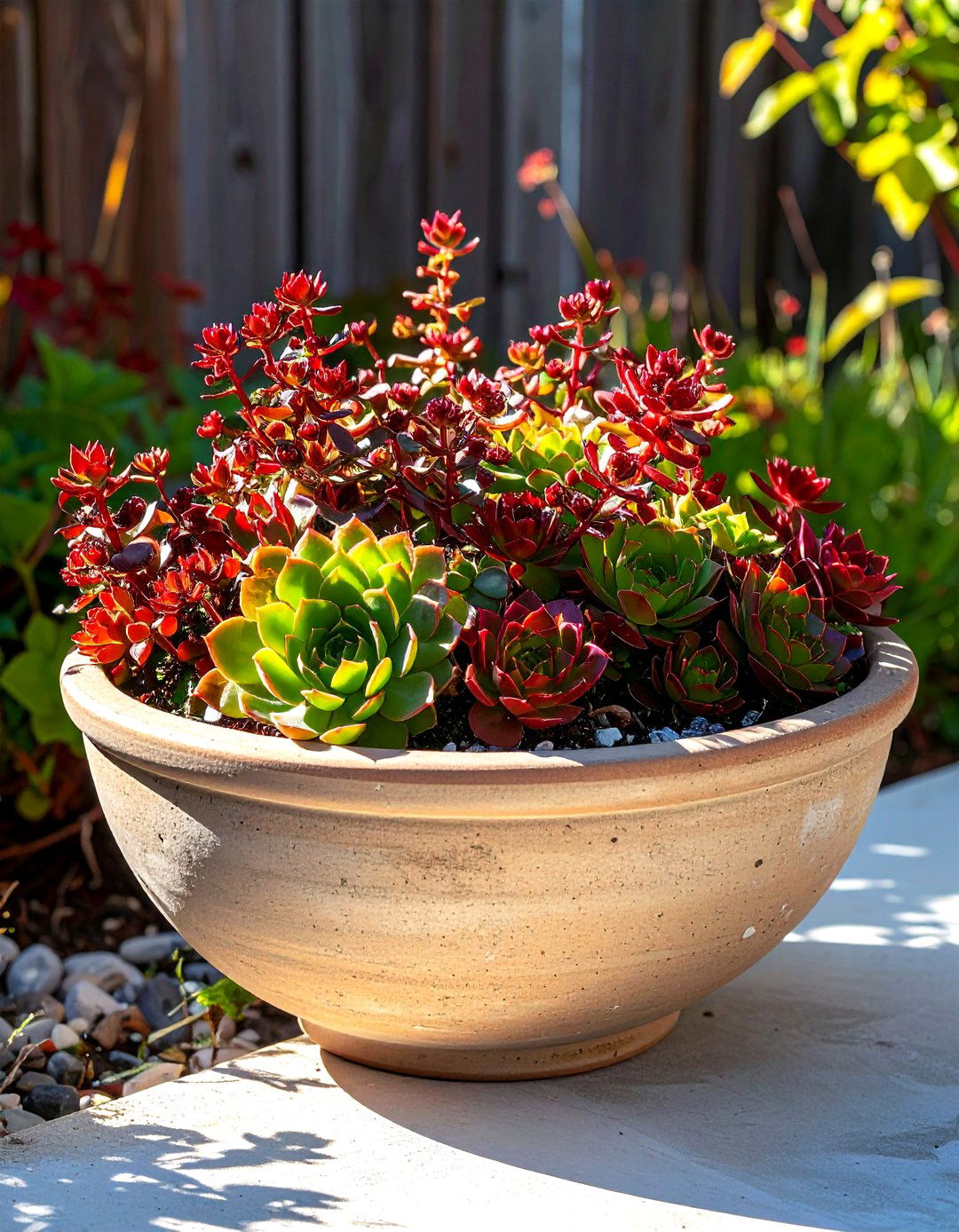
If your patio bakes, a bowl of sedum stonecrop provides year-round interest with almost no watering. Many sedums are both sun and heat tolerant, shrugging off short dry spells typical of container life. Use gritty, sandy soil and a shallow dish-style pot to echo their alpine origins. Trim blooms after they fade to keep rosettes tidy, or leave seed heads for winter texture. Combine several colors and heights for a miniature, low-maintenance rock garden within arm’s reach of your lounge chair.
14. Clumping Bamboo Builds a Living Screen Without the Worry
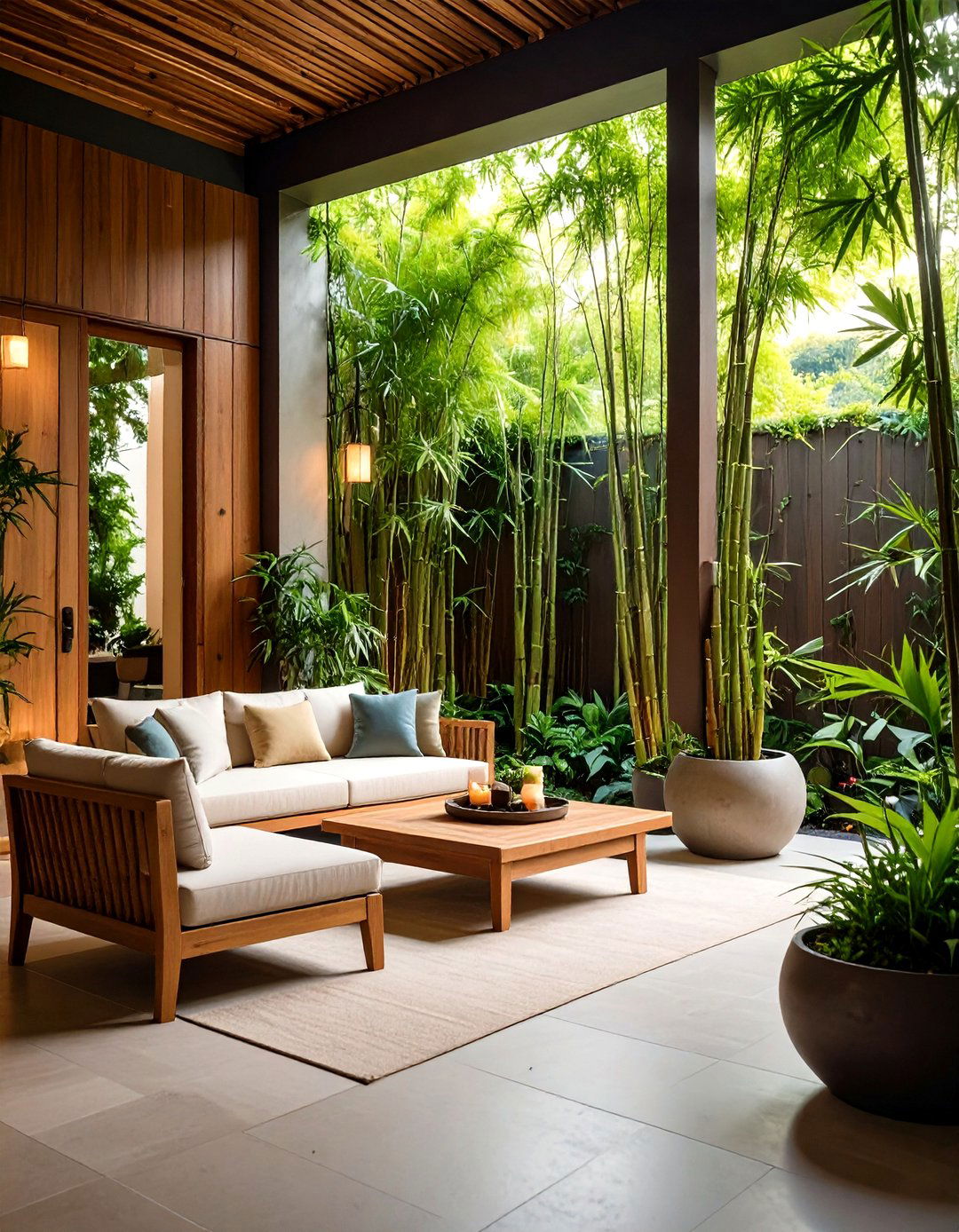
Hardy Fargesia bamboos stay in neat clumps, expanding only a few centimeters a year, so they’re safe for patio pots and won’t escape into beds. Site the container where it receives morning sun and afternoon shade, and water deeply twice a week during heat. A yearly top-dress with compost and slow-release fertilizer keeps culms green and upright. The tall, whispering foliage adds instant privacy and a soothing rustle — perfect for screening neighboring windows or busy streets.
15. Dwarf Lemon Trees Perfume Patios With Citrus and Blossom
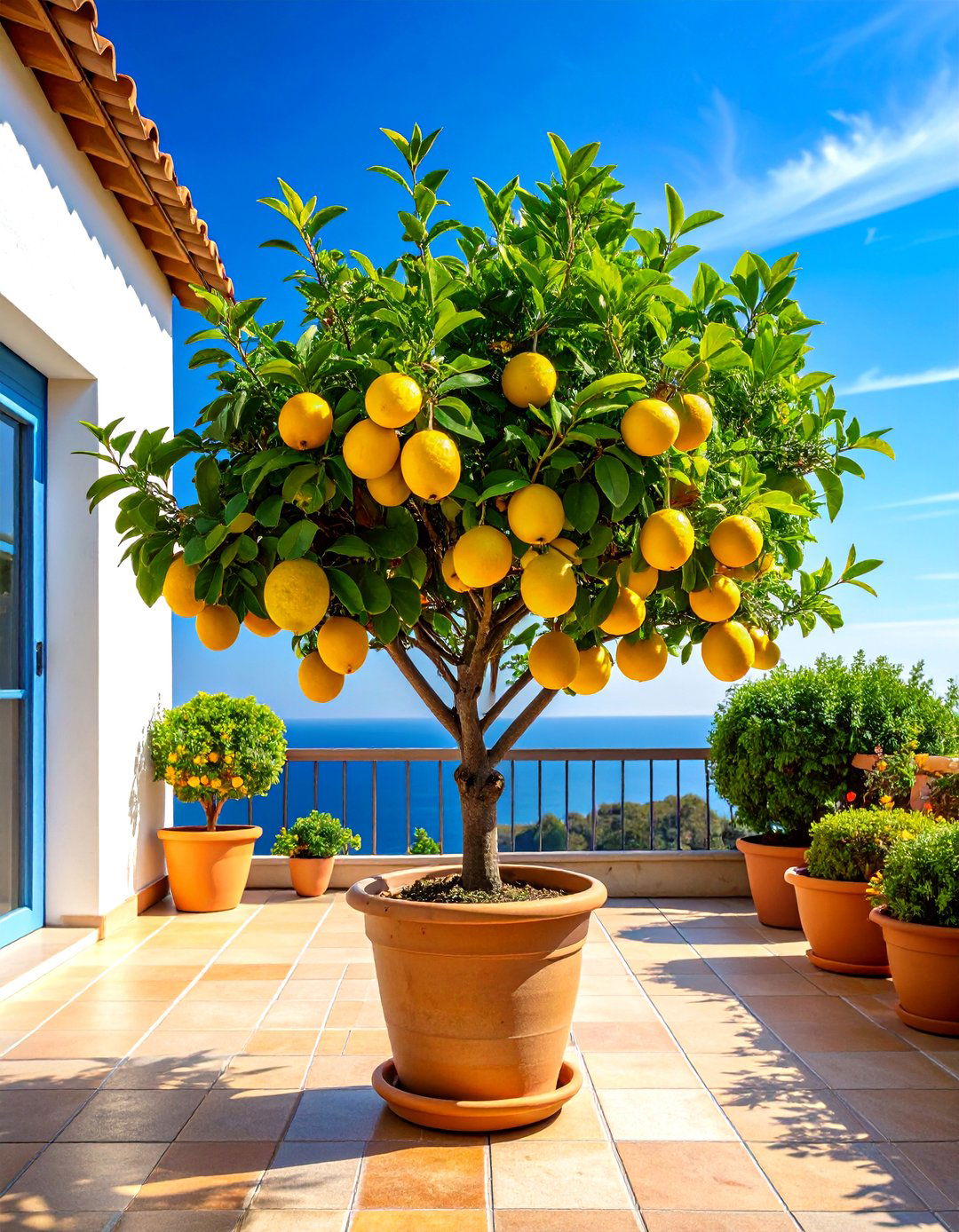
Imagine plucking fresh lemons where you grill — dwarf citrus makes it possible. Potted trees need at least six hours of direct light, and eight or more for reliable fruiting. Use a slightly acidic, well-draining mix amended with perlite, and water when the top inch dries. Monthly feeding with a citrus-specific fertilizer keeps leaves glossy and fruit plentiful. Wheel the pot indoors before frost, placing it under grow lights if natural sun wanes. Few outdoor plants for patio living provide fragrance, shade, and cocktails all in one package.
16. Heuchera Adds Jewel-Toned Foliage to Part-Shade Containers

Coral bells excel where morning sun meets afternoon shade, their ruffled leaves ranging from plum to chartreuse. Choose a wide, shallow pot to showcase their low mounding form and wiry flower spikes. Keep soil lightly moist and remove spent blooms to tidy the clump. Because leaf color intensifies in cool weather, heuchera extends interest into autumn when many annuals fade. Group several cultivars for a living tapestry that thrives even on north-facing patios.
17. Salvia Spires Feed Pollinators From Spring to Frost
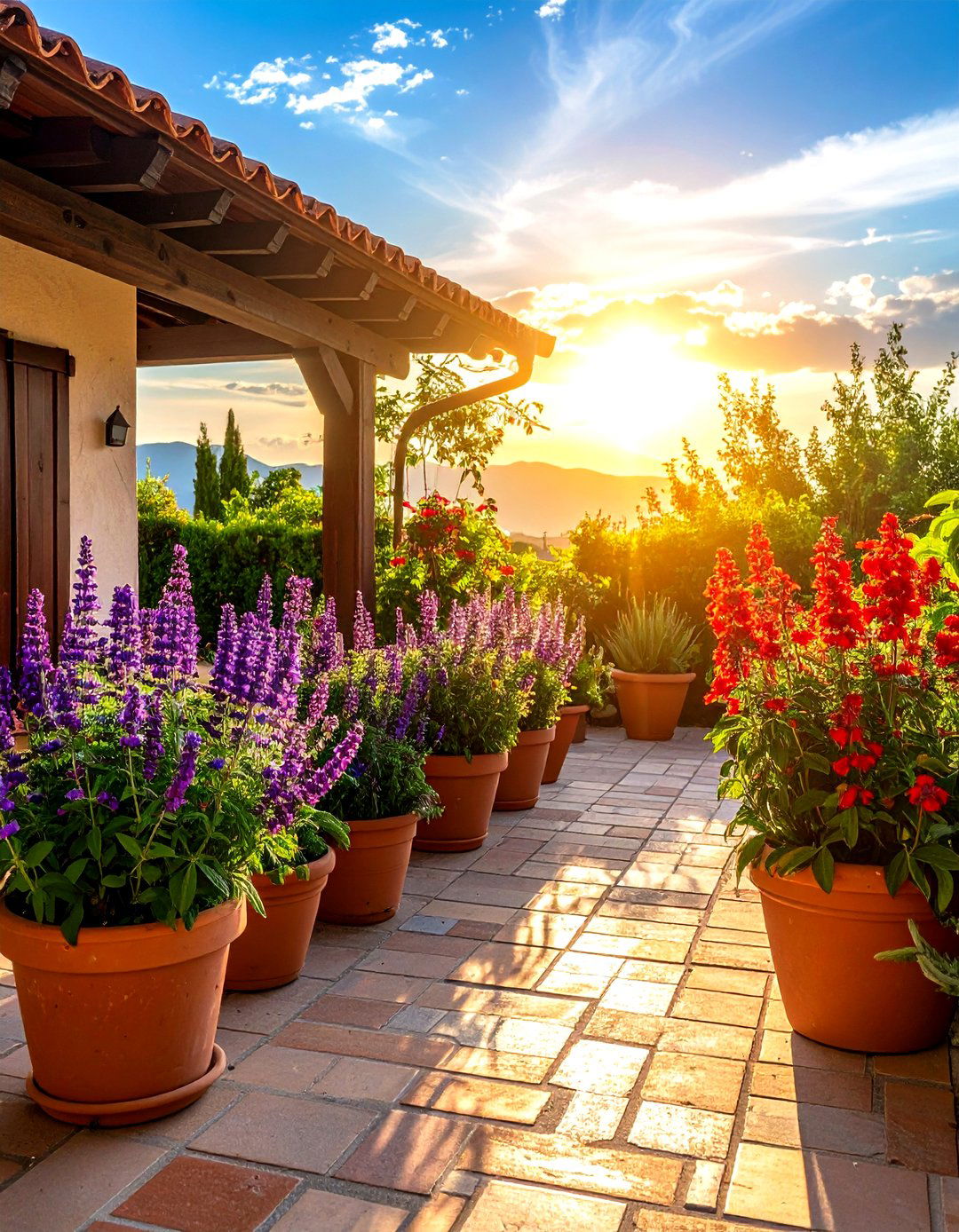
Give ornamental salvias six to eight hours of direct sun and they’ll reward you with aromatic foliage and vertical flower wands all season. Well-drained soil prevents root rot; drought tolerance means less mid-summer fuss. Deadhead fading spikes to trigger new bloom cycles, ensuring a buffet for hummingbirds and butterflies throughout patio season. Most cultivars stay under 60 cm in containers, so they tuck easily among furniture without crowding pathways.
18. Blue Fescue Grass Supplies Year-Round Steel-Blue Tufts
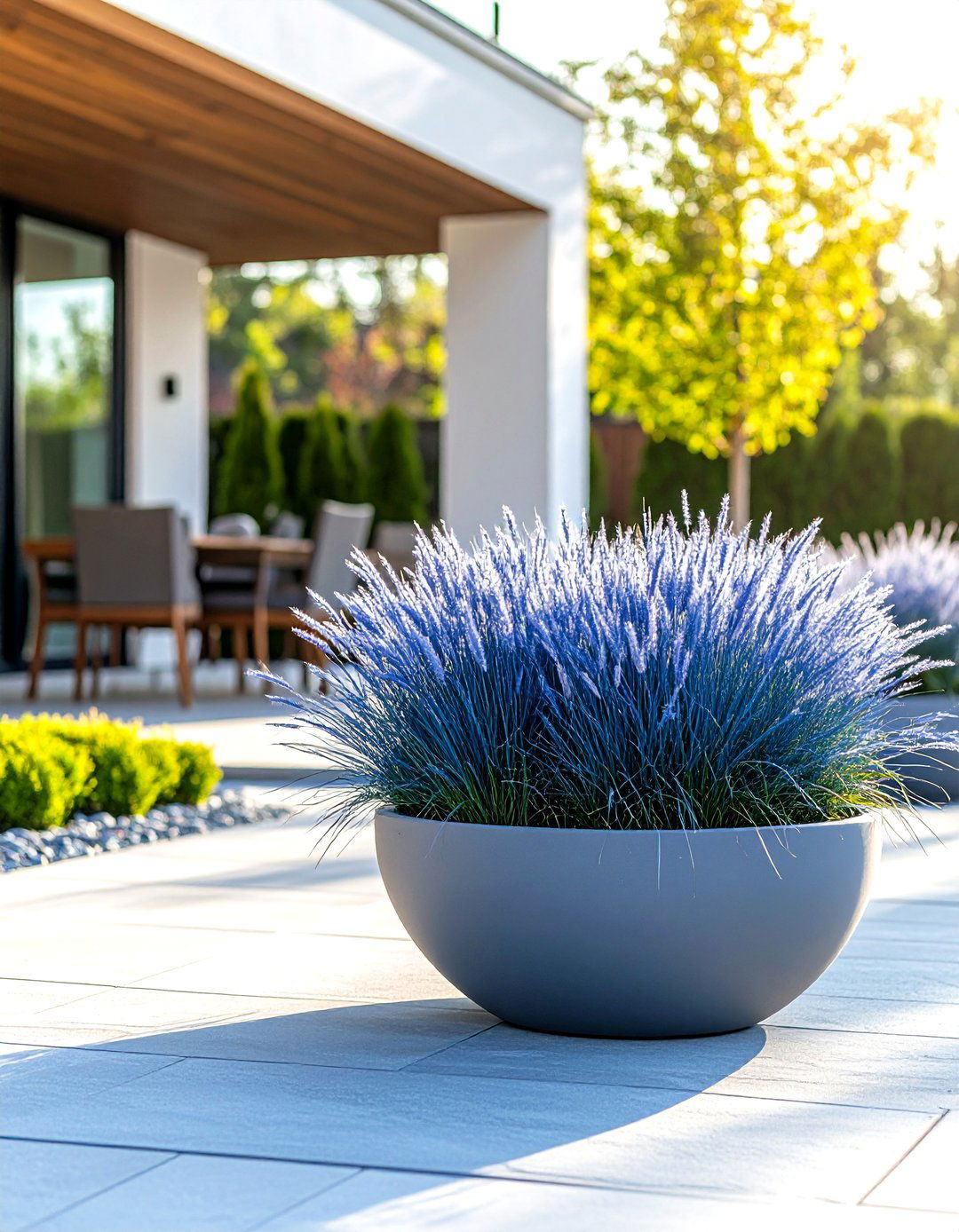
Festuca glauca’s silvery clumps bring fine texture and tranquil color to minimalist patio schemes. The grass is valued for its drought tolerance and ability to thrive in containers or at bed edges. Full sun intensifies its blue hue, while well-drained sandy soil prevents crown rot. Shear spent flower stalks in midsummer to keep the mound tight. Because it stays under 30 cm tall, blue fescue slots neatly among taller pots without blocking views.
19. Wax Begonias Bloom Reliably in Bright Shade
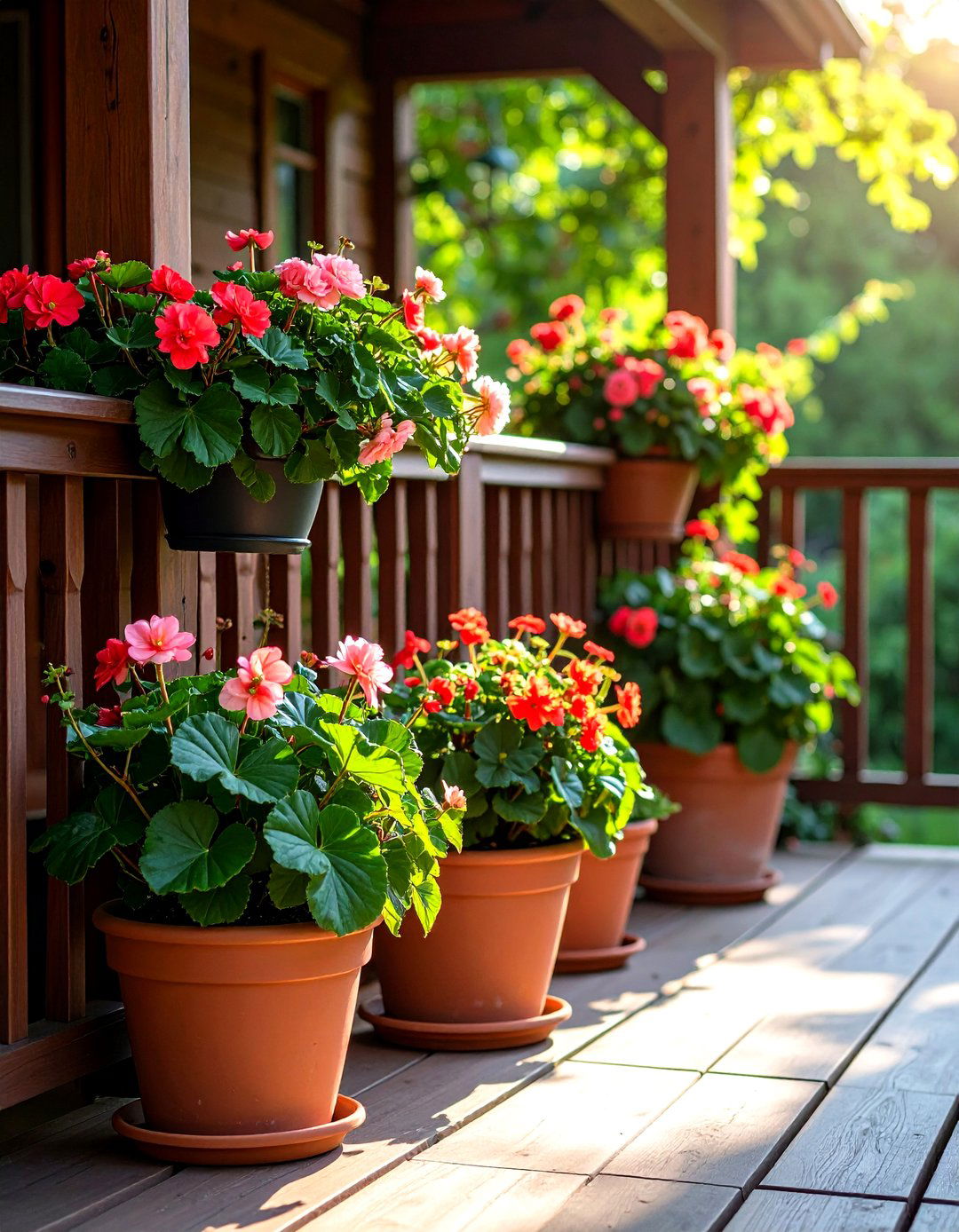
Wax begonias answer the call for continuous color where sun is limited. They tolerate dappled shade yet still pump out pastel blooms and glossy leaves. Choose a rich, moisture-retentive mix and water when the surface feels dry; begonias dislike both extremes of drought and saturation. Pinch the tips to reduce legginess and remove spent clusters for a perpetual floral show. These outdoor plants for patio rail planters perform until frost with very little intervention.
20. English Ivy Drapes Railings With Evergreen Elegance
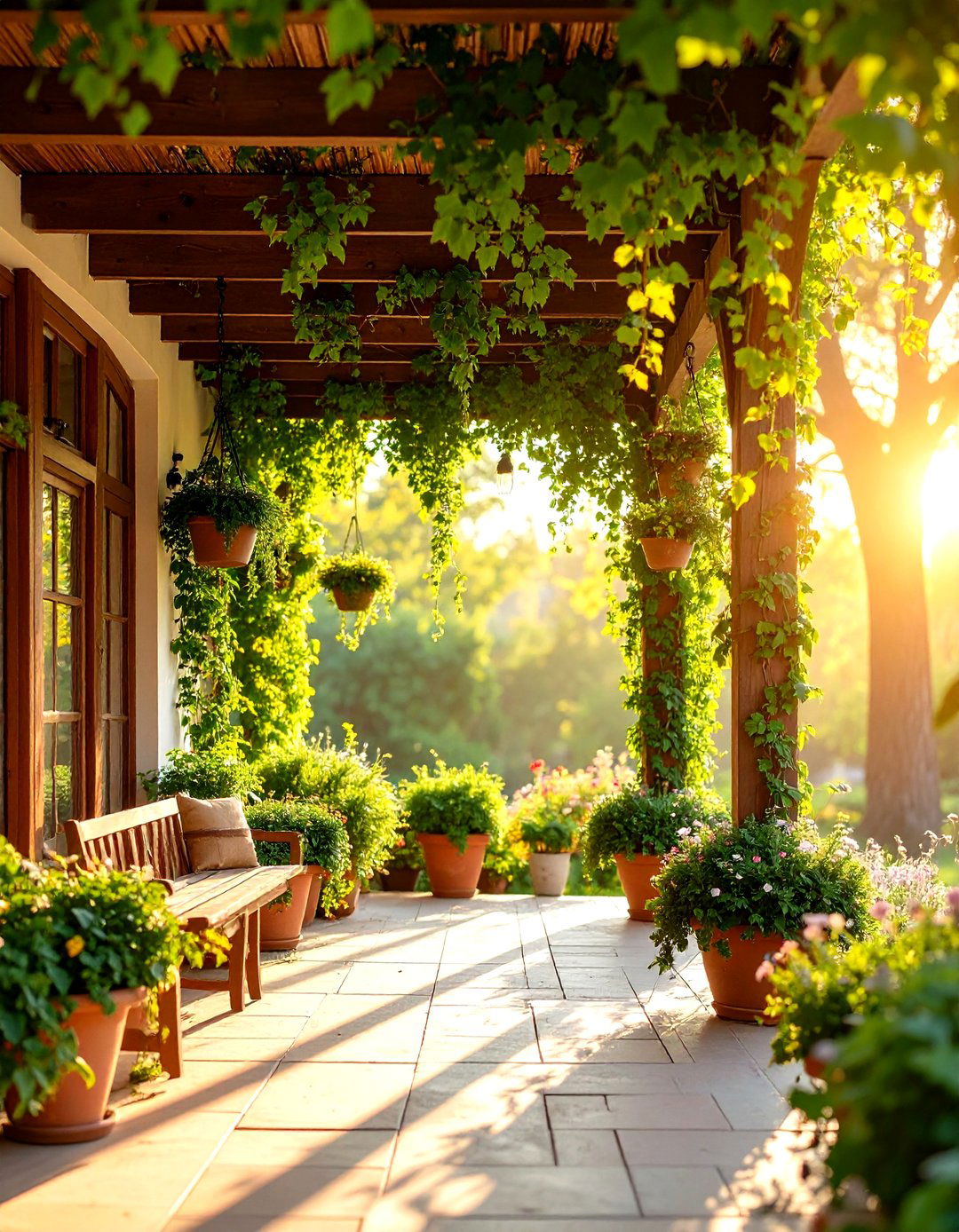
For instant trailing greenery, English ivy is surprisingly cooperative in pots, staying contained and easy to prune. Provide moderate light — too much direct sun scorches leaves — and allow the top half-inch of soil to dry before watering. Train vines around a wire topiary or let them spill over tall urns to soften edges. Trim runners regularly to manage length and encourage denser foliage. Its evergreen habit ensures year-round texture even when annuals call it quits.
21. Tropical Hibiscus Delivers Supersized Blooms on Sunny Decks

Nothing says “vacation at home” like hibiscus saucers the size of dinner plates. Growers recommend full sun in cooler regions and filtered light in intense southern heat to prevent leaf scorch. Keep the soil consistently moist — up to 5 cm of water weekly — and feed regularly for a steady succession of blooms. Because hibiscus hates cold, wheel the pot indoors before temperatures dip below 10 °C. Prune lightly in spring to shape and encourage new flowering wood capable of another patio-side spectacle.
22. Hostas Shine in Container Shade Gardens
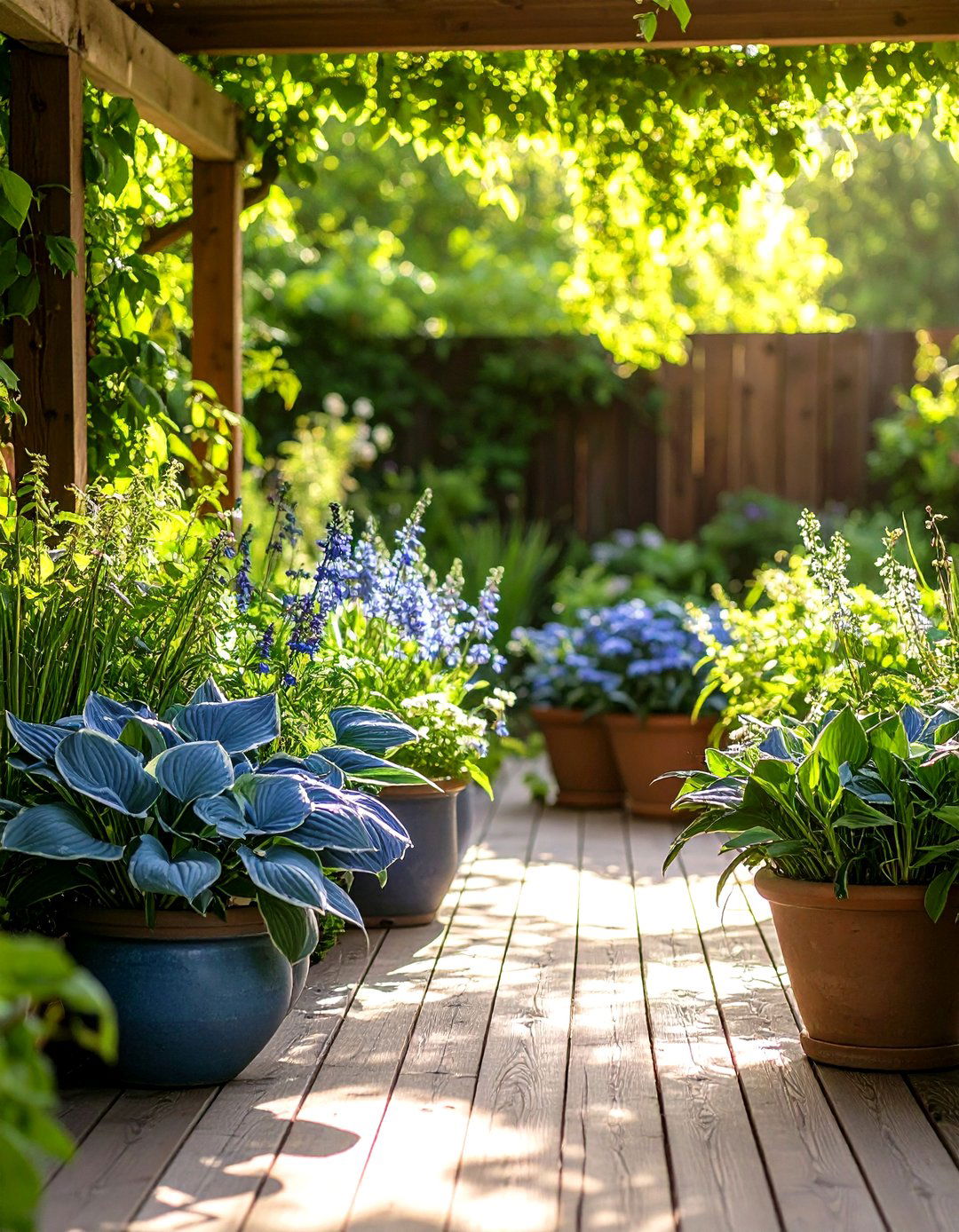
Large-leaf hostas transform dim corners into lush, tropical retreats without demanding flowers. Varieties with blue or green foliage prefer deeper shade, while yellow or gold types need a touch more light to color up. Use a rich, moisture-retentive mix and water whenever the surface dries — they wilt quickly if parched. Divide congested clumps every three to four years to maintain vigor. Pair hostas with upright accents like dwarf Japanese maple for a layered patio planting that feels like a curated woodland.
23. Cool-Season Pansies Keep Color Alive in Shoulder Months
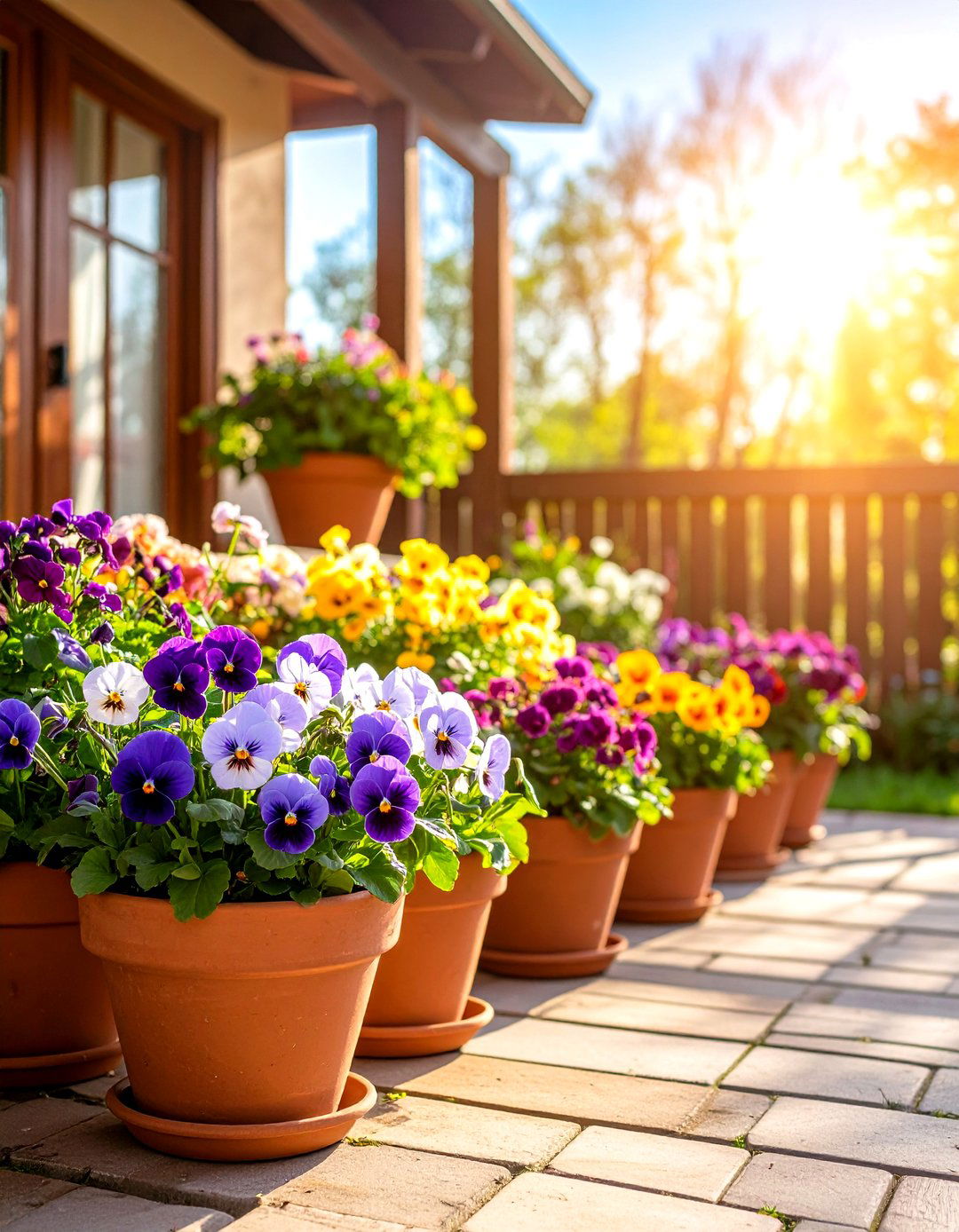
When summer annuals tire, pansies and violas step in with cheerful faces that laugh at chilly nights. They bloom best in full to partial sun and loose, fertile compost, making them perfect for early-spring or autumn patio pots. Water consistently and deadhead to prevent seed set and extend flowering. Because they’re shallow-rooted, even window boxes support a vibrant show. Combine complementary hues for jewel-box intensity that greets guests before the front door even opens.
24. Edible Nasturtiums Trail Brilliantly Over Pot Edges
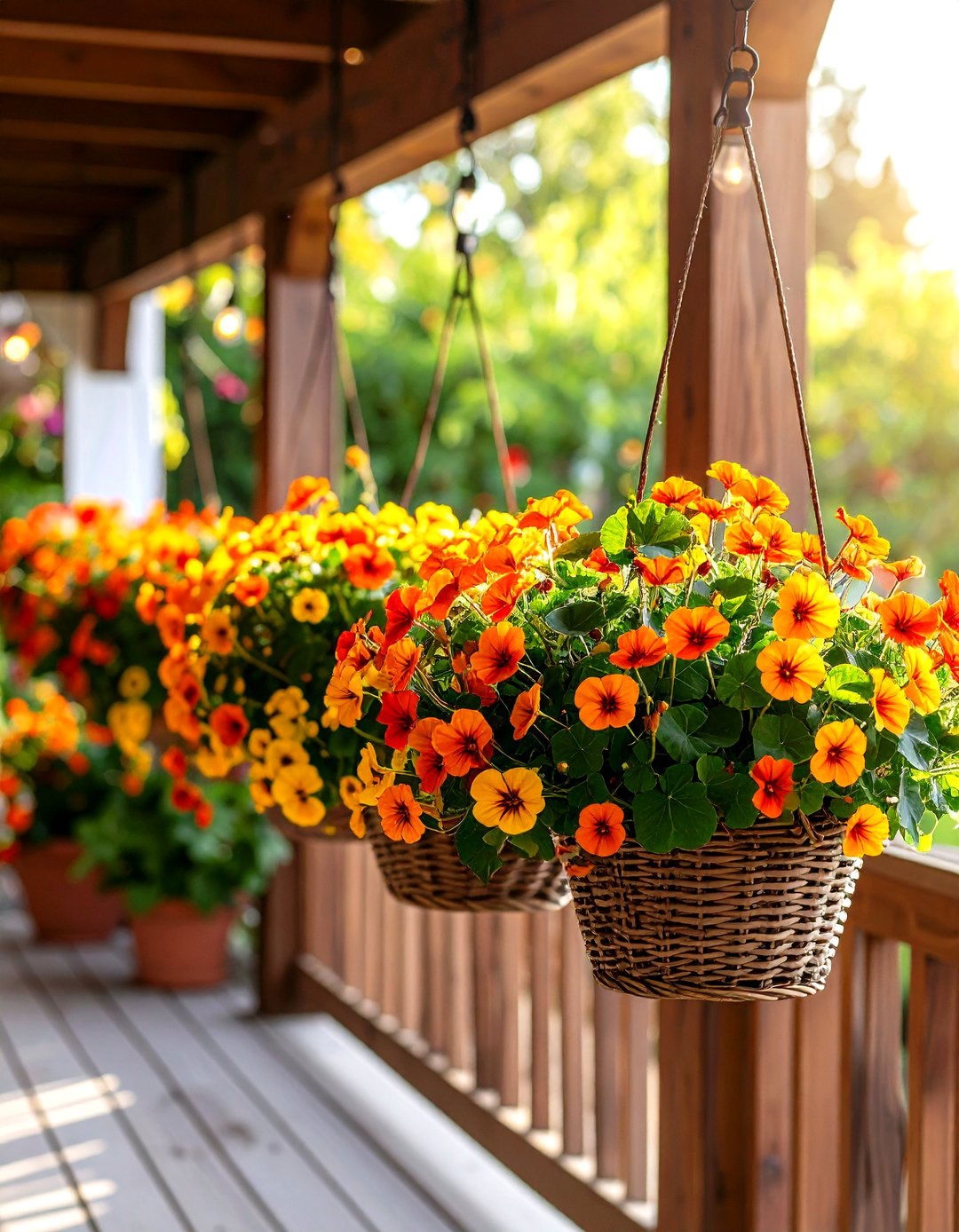
Nasturtiums thrive in poor, well-drained soil and full sun, so they’re tailor-made for lightweight hanging baskets and rail boxes. Rich mixes generate more leaves than flowers, so resist the urge to over-fertilize. The peppery blooms and leaves add edible decoration to patio salads — pick often to spur fresh buds. Water when the top inch dries; the plants forgive short droughts but sulk in waterlogged media. Their relaxed habit brings a cottage-garden vibe to contemporary patios.
25. Dwarf Olive Trees Provide Mediterranean Style in Compact Spaces
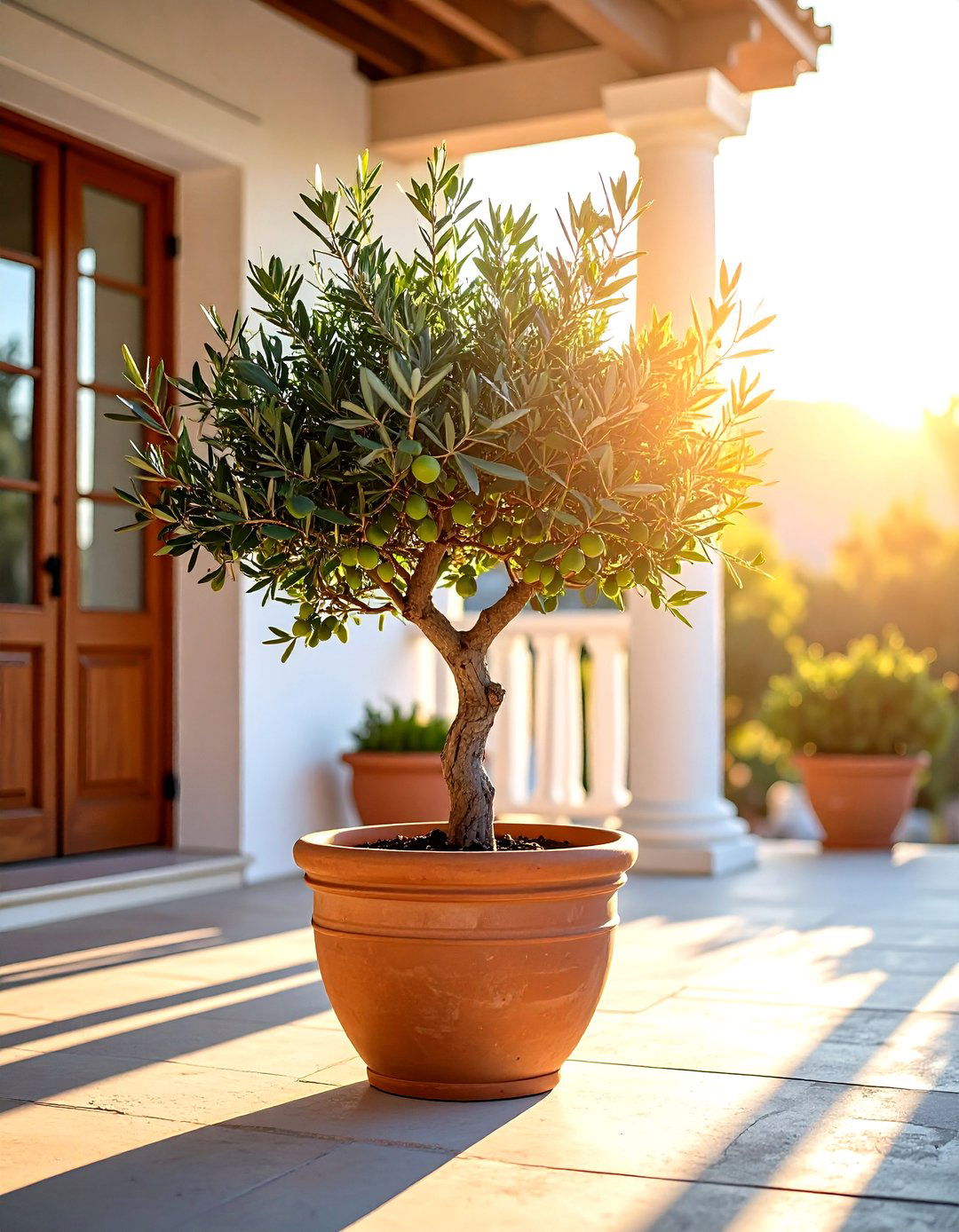
Silver leaves, sculptural trunks, and the promise of home-cured olives — dwarf Olea europaea is increasingly popular as an outdoor plant for patio living. Provide the brightest spot available; these sun lovers prefer at least six hours of direct light and well-draining soil, going easy on water to mimic arid origins. Fertilize sparingly in spring with a balanced formula, then prune lightly to maintain size and improve airflow. Wheel pots into a cool, frost-free space over winter in cold climates, and you’ll enjoy evergreen glamour year after year.
Conclusion:
With the right match of light, container, and care, patio plants can transform even the smallest slab into a multiseason oasis rich with color, scent, and sound. From drought-tough lavender to shade-loving hostas, each selection above offers practical beauty and, often, culinary or ecological bonuses that make outdoor living more rewarding. Mix evergreen structure with seasonal stars, keep soil aerated and drains clear, and your patio garden will thrive as an inviting extension of your home.


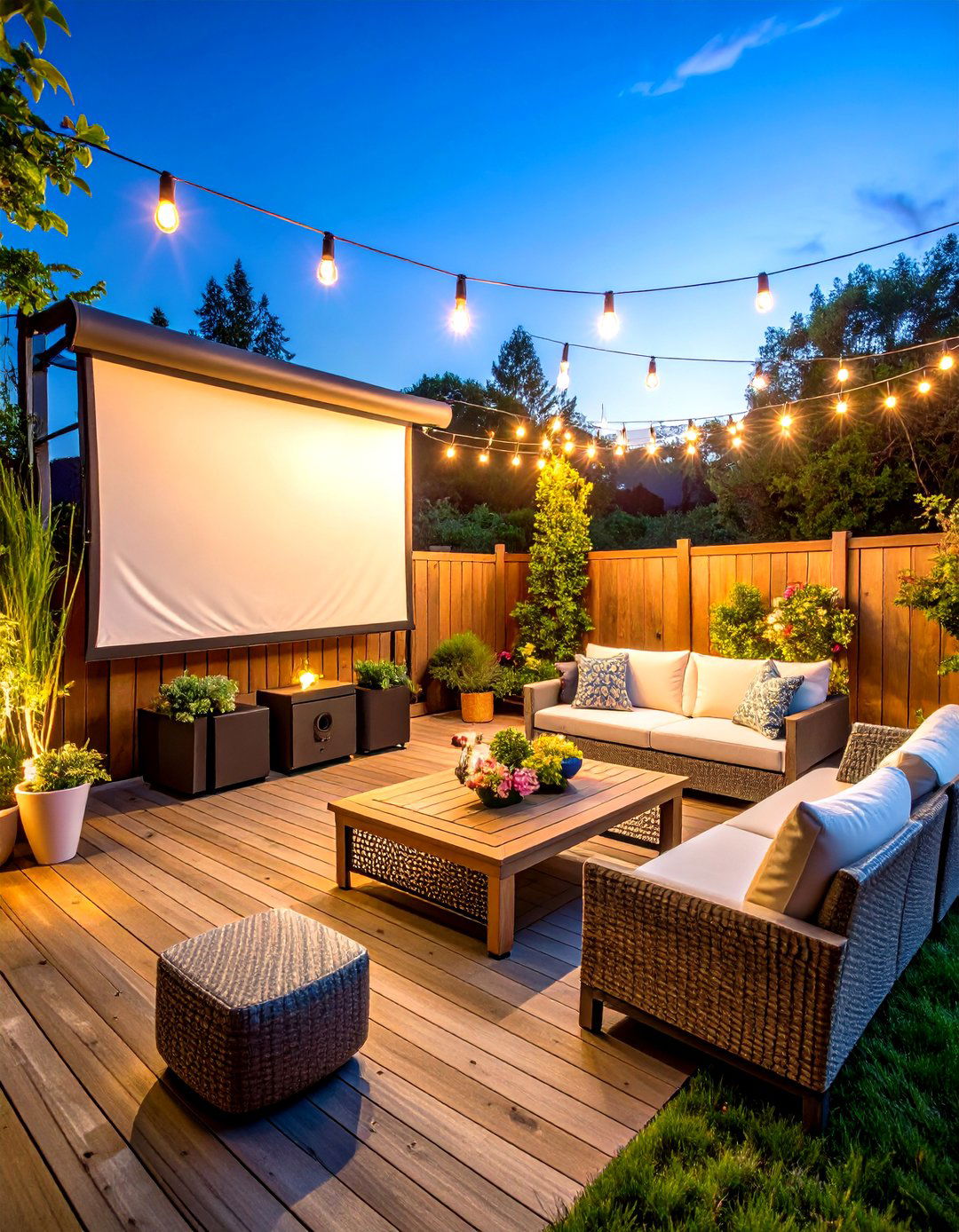

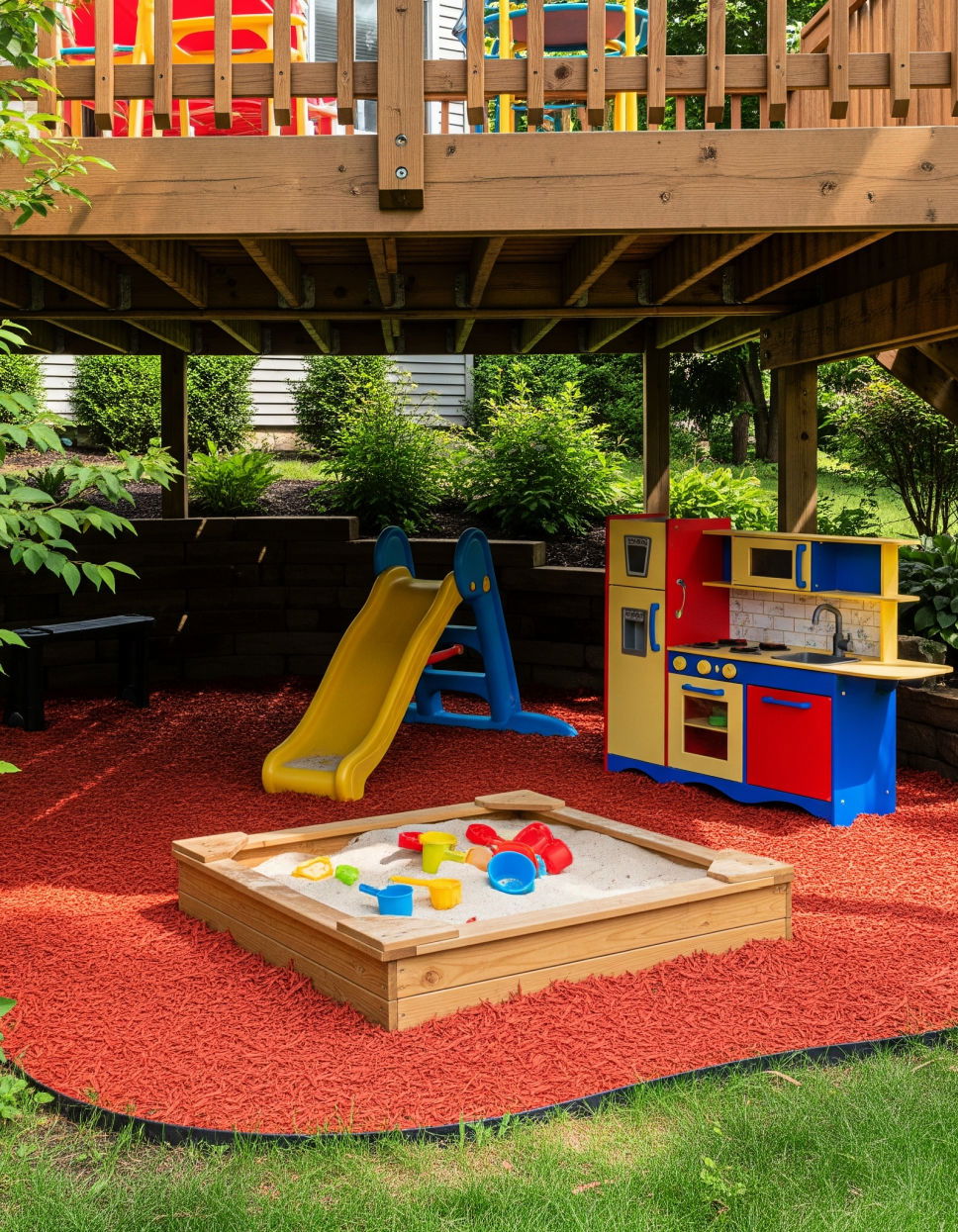
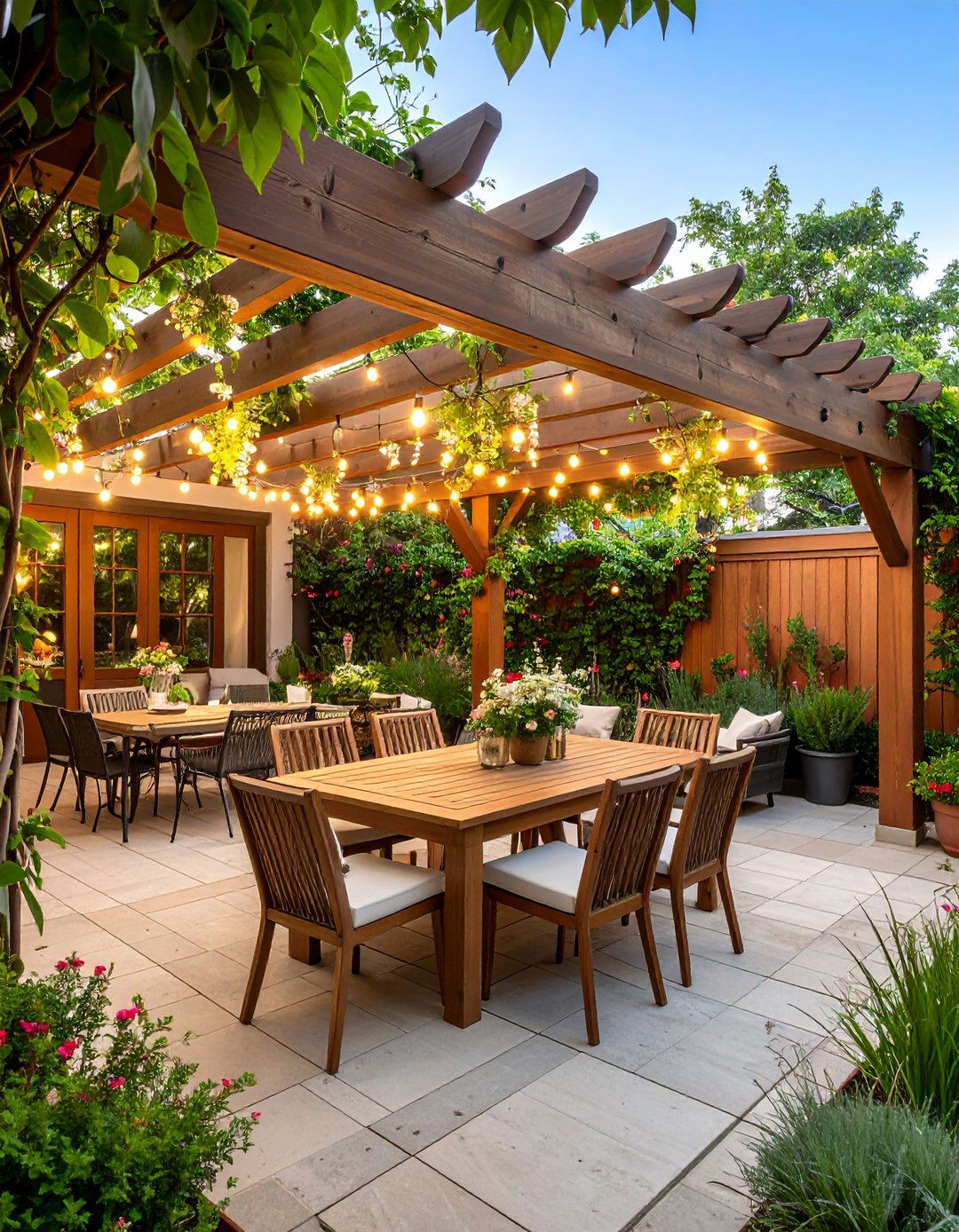
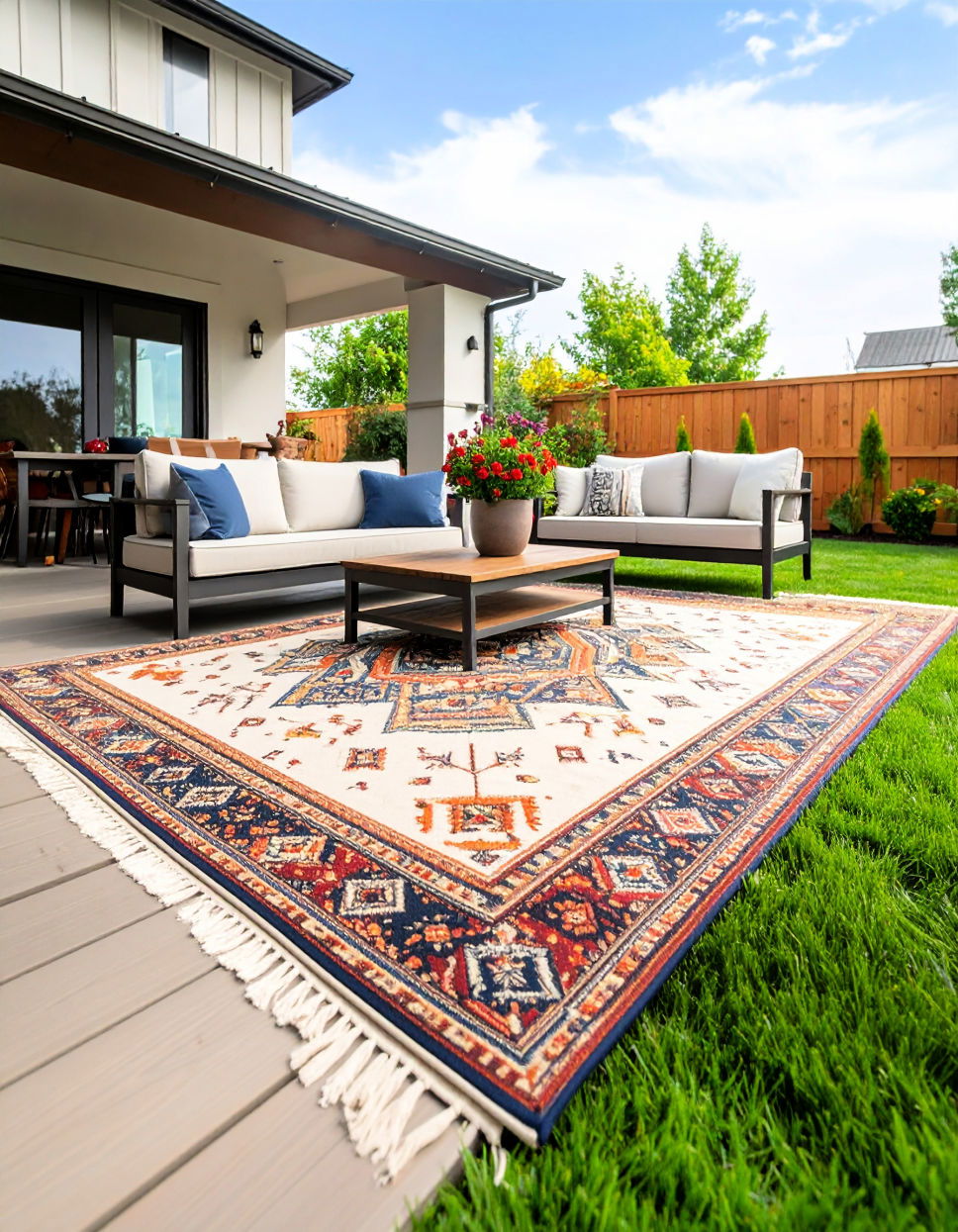
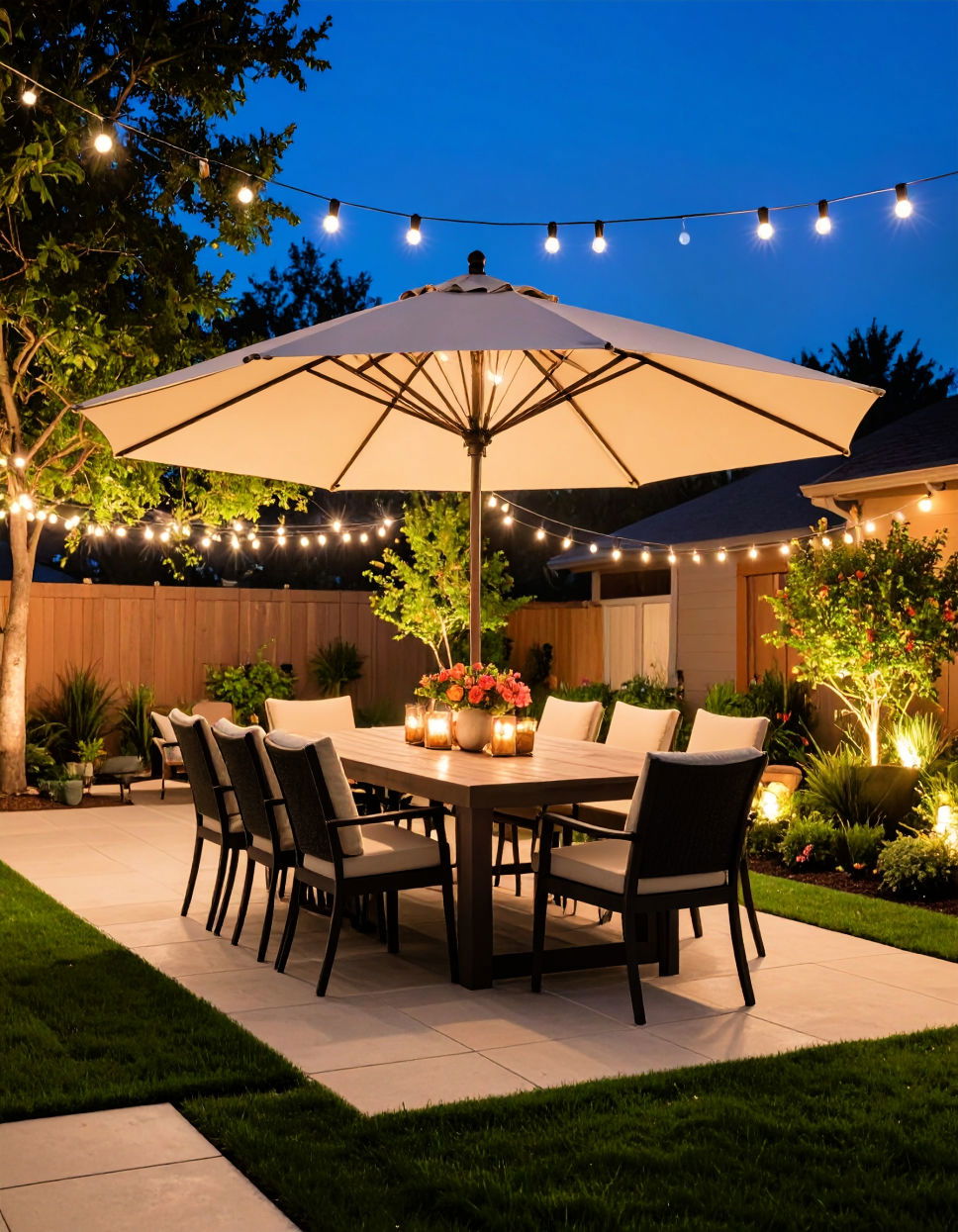
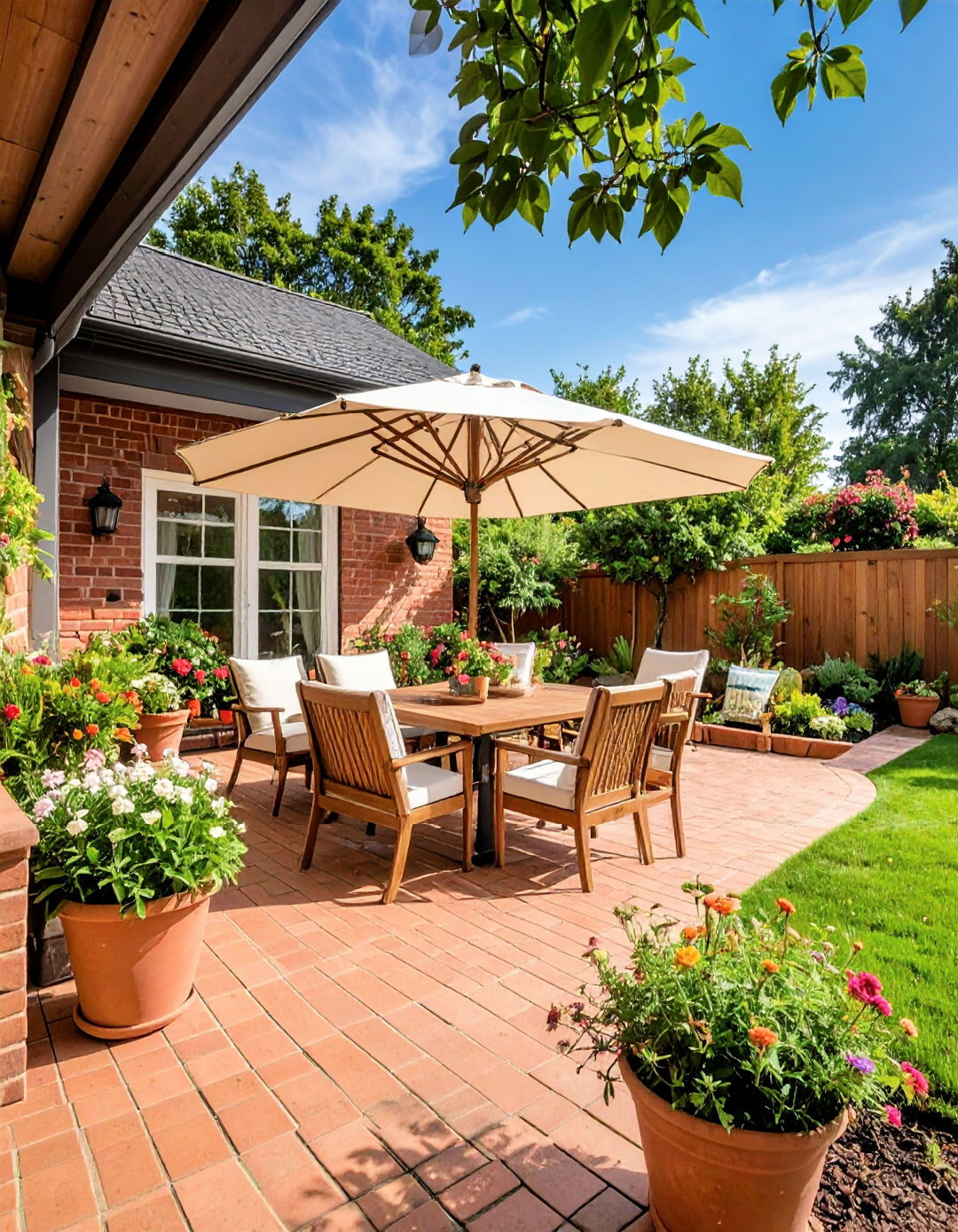
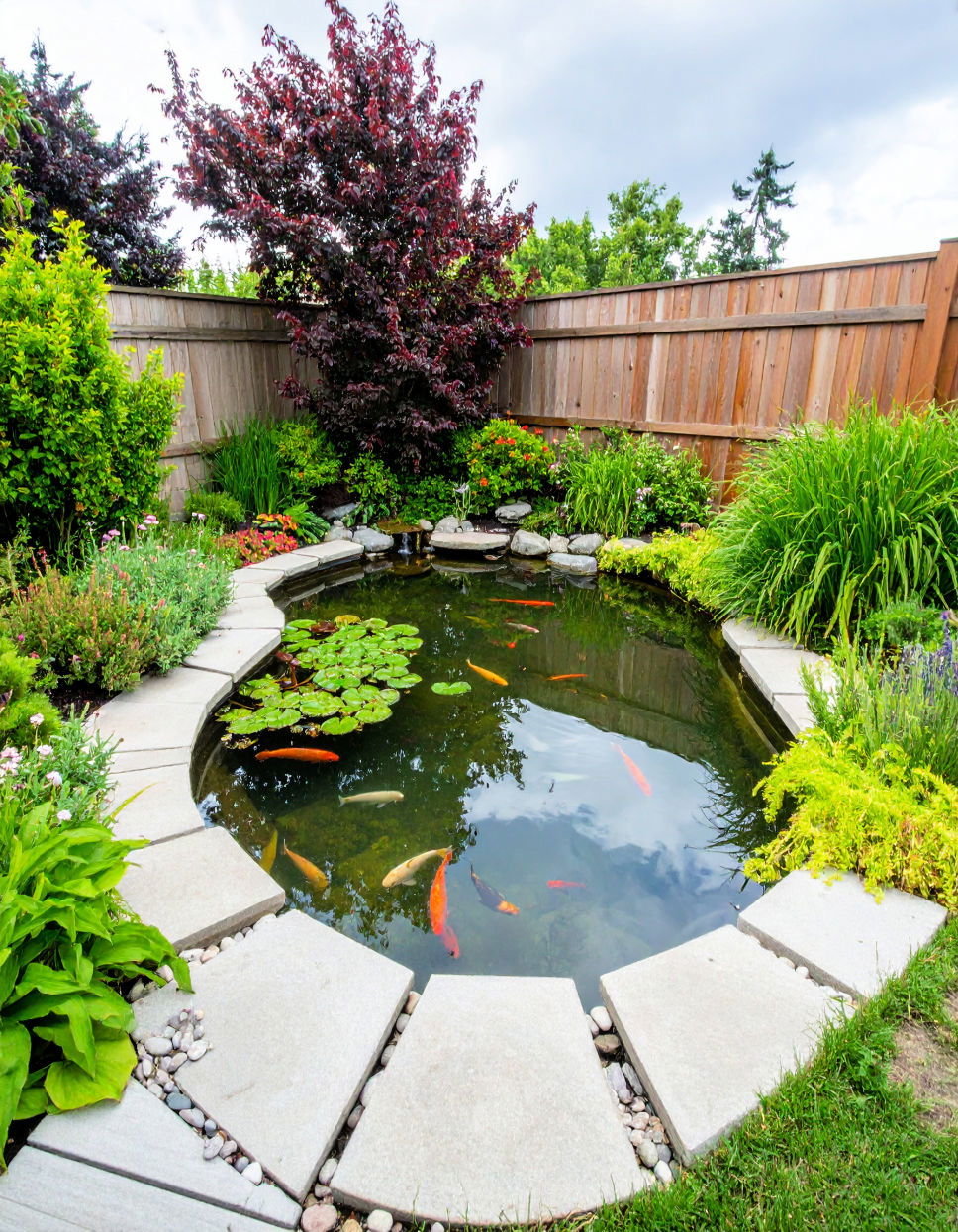

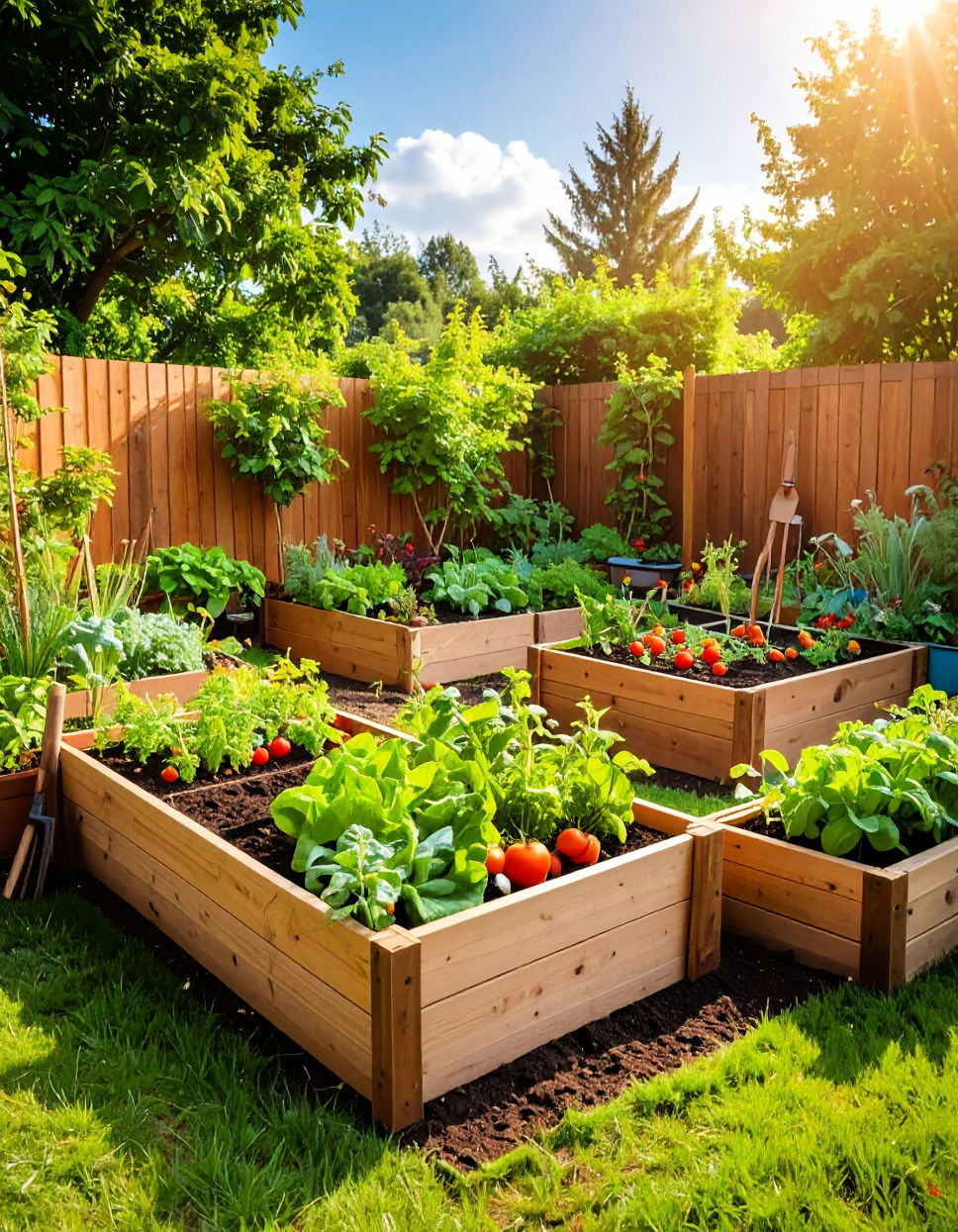
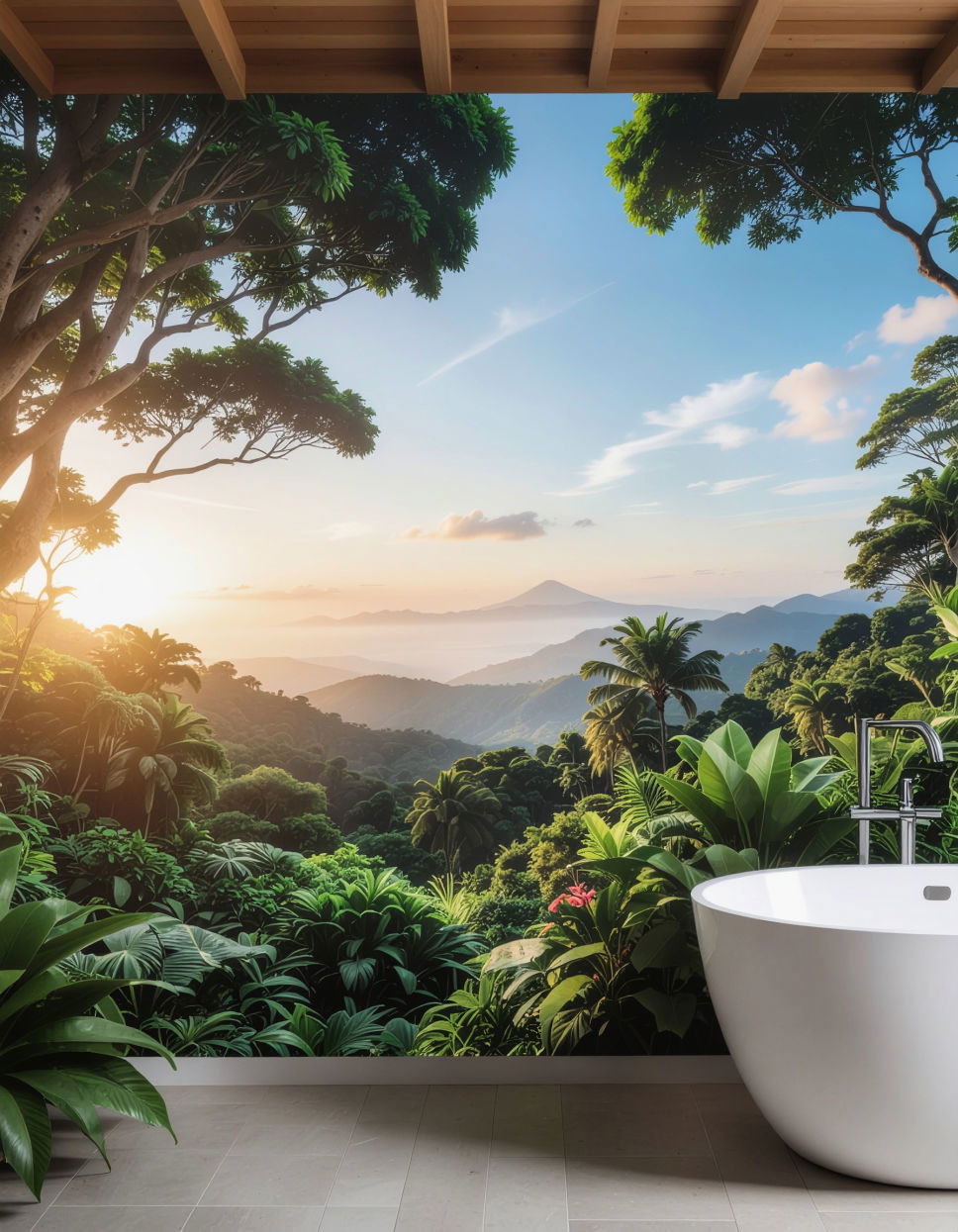
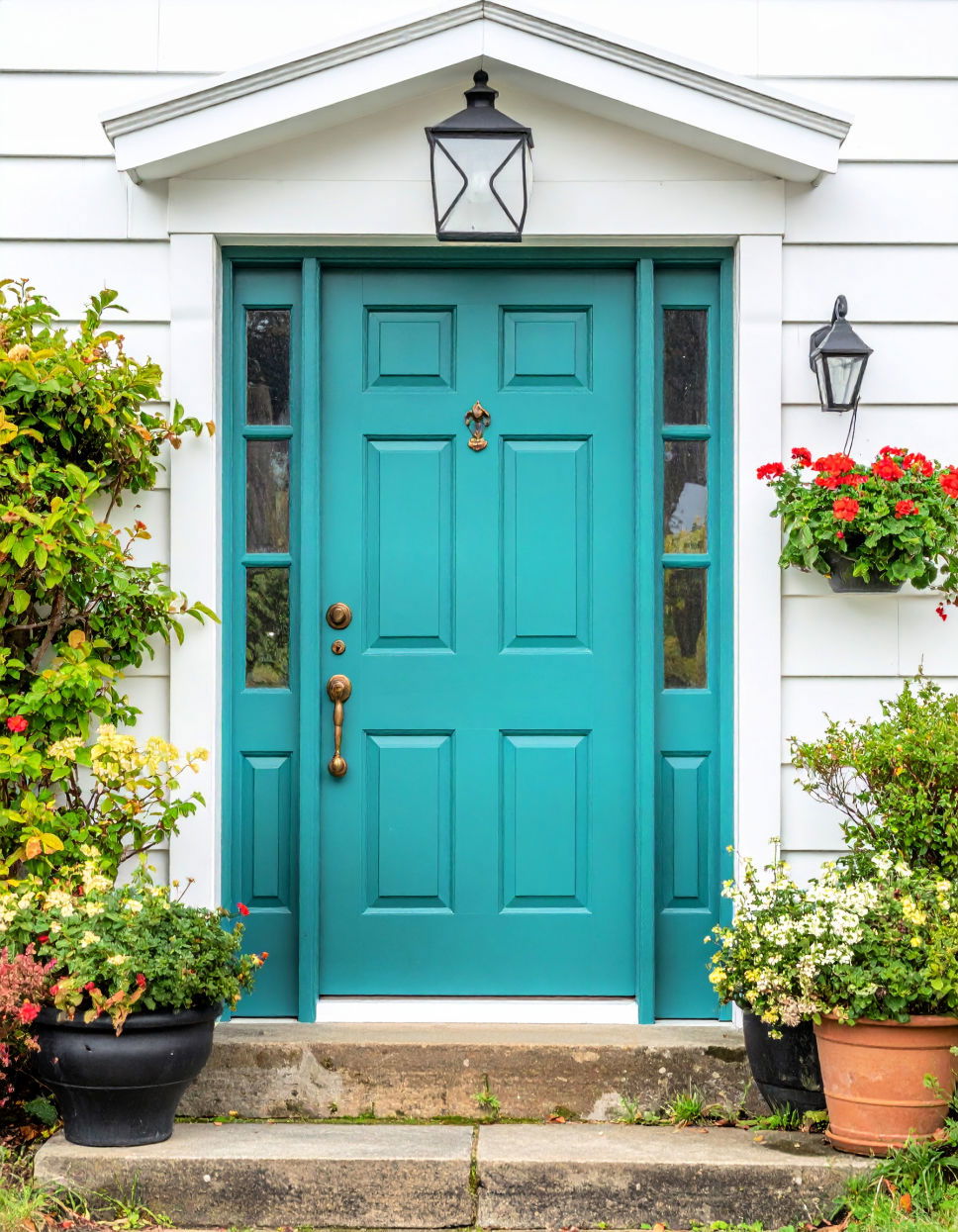

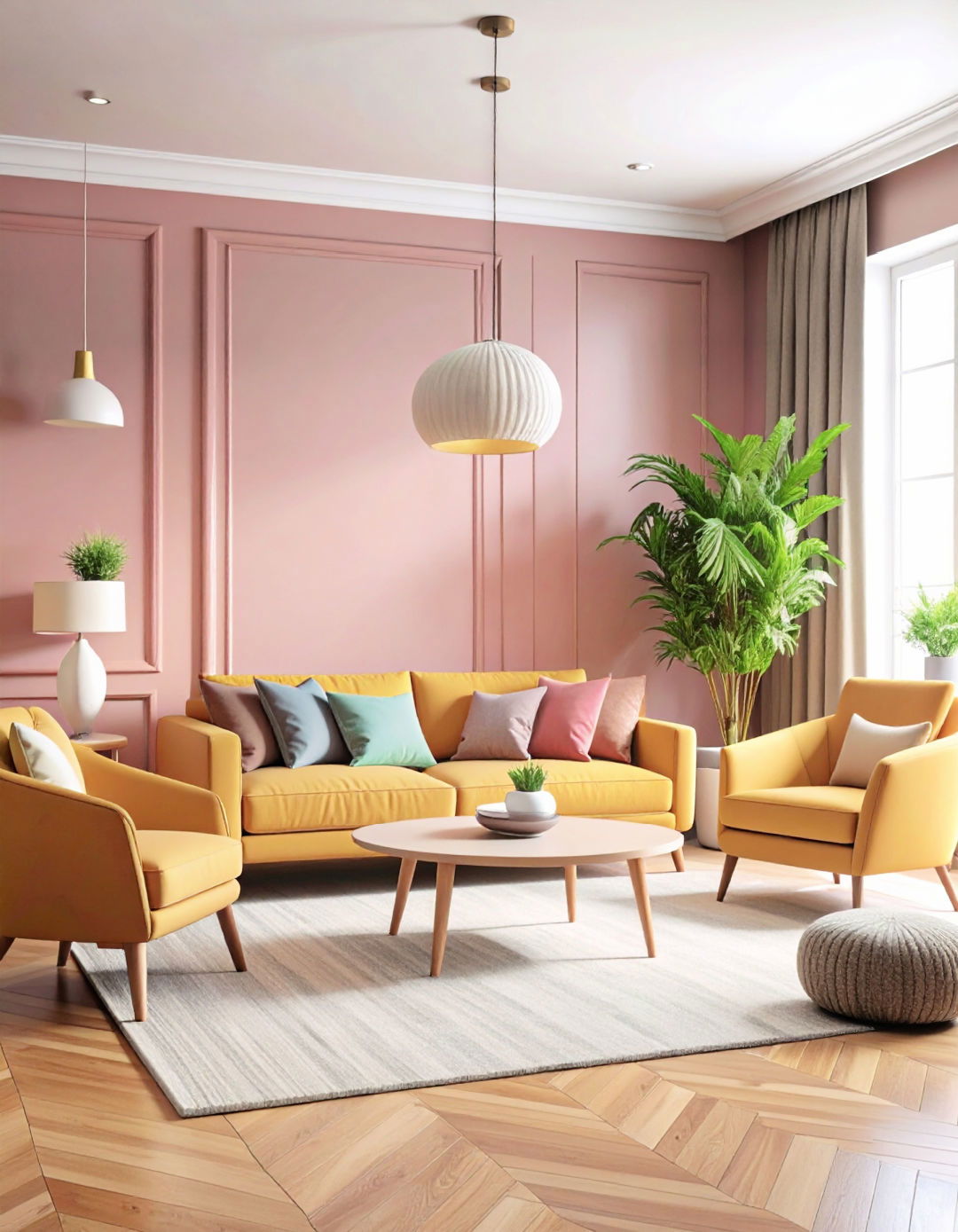

Leave a Reply